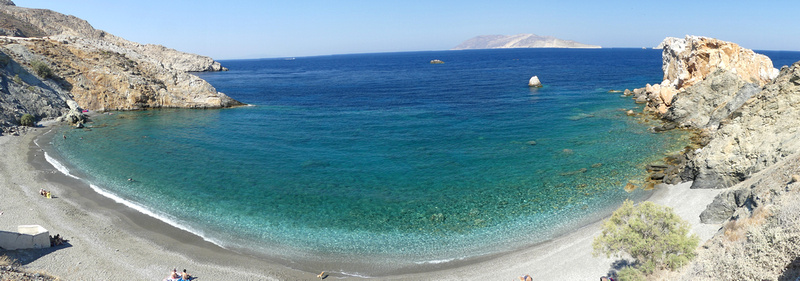


Bavaria to Bratislava and Back: Part 1 Munich, Hallstatt, Graz, Bratislava and the Wachu Valley
The itinerary may not one a lot of people would probably take – it skips Salzburg and Vienna (been to both on previous trips) and includes places like Graz that most people haven’t even heard of, but it served my purposes – to see some places I’ve missed on previous trips like Bratislava, and several UNESCO sites (Hallstatt, Graz, Wachu Valley, Bamberg, Regensburg) and my husband’s desire to check out a lot of Bavarian beer (he’s a home brewer/beer snob). It included:
Munich 3 nights, Hallstatt 1, Graz 3, Bratislava 3, Wachu Valley 2, Nurnberg 3 (day trips to Bamberg & Regensberg), Rothenburg o.d. Taber 1, Heidelburg 2.
Turns out a lot of travel forum folks were right about three nights in Graz and Bratislava being too much (could have cut a day from each). But I was right about the one nighters. Hallstatt was hugely crowded with tour groups during the day, but was almost deserted evening and early morning. Pretty much the same with Rothenburg.
We did all our traveling by TRAIN The first one I booked on bahn.de, the official German train website. It was easy to use, but Capital One Visa did not like it at all and refused all subsequent attempts, so I ended up booking all the rest on “thetrainline.eu” which had the exact same schedules and prices as the German and Austrian sites. The only problems we had with regards to trains were some very short connection times. The main screen you get when searching (on any of the sites) showed departure and arrival times and how many connections there were, but to see details such as how long you had for the connection, you had to go to another screen, which I didn’t do as I ‘assumed’ if they were booking a journey from point A to point B, it would be a ‘doable’ connection. Sometimes they were only 3 or 4 minutes long meaning we had a few stressful moments. Although I don’t think any of the trains we took were totally full (so you could have purchased them on the day of travel) it did save considerably financially. In one case I checked the price of the €19.90 tickets we had and the price if we bought them that day would have been €49.90.
MUNICH
Days 1-3: We arrived in Munich around noon after our flight from Boston, via Dublin. Hotel Buddy – Uber modern. Check in on the ground floor kiosk or go up to the 2nd floor where there is another kiosk but also a nice lady to help you. The comfortable queen size bed is up against the wall but other wise fine. No closet or dresser but enough space for the two bags and surfaces to put stuff. Bathroom very modern, great rain shower, everything extremely new and clean. Could use a few hooks on the walls. AC, TV and fast wi-fi all worked great. The ‘free’ Buddy breakfast – I guess it was ‘worth the money’ - includes some cheap pastry and apples, vending machine has so-so cappuccino for €2. They set it out at 6:30 am, there may or may not be any left when you get up. €112 double (including the €10 extra for the ‘larger’ size room.)
Location is great, 5 minutes from the train station and one-minute from Karlz-platz, underneath which is a huge underground shopping center/food court. Escalators go down to it so it serves as a passage to go under the relatively busy Sonnen-strasse (one of which comes up almost directly in front of Hotel Buddy). Food options include Mexican, Indian, Thai, Kebab, Pasta, ‘traditional German (ham, schnitzel, etc.), sausage and fries, and numerous salad/sandwiches. One of the best-preserved city gates, (Karls-tor) is on Karlzplatz, through which is pedestrian street into town.
The Neuhauser-strasse / Kaufinger-strasse is lined with some interesting buildings interspersed with more modern (late 20th century) buildings – all of which house stores like Urban Outfitters, H&M, C&A, Zara, etc. The street was spruced up in 1972 for the Munich Olympics, becoming one of Europe’s first pedestrianized streets. St. Michael’s church is right on the street; set off by a half block is the Frauen-kirche, the tallest thing in central Munich with twin clock towers topped with green onion domes. Five minutes brings you to the Marien-platz.
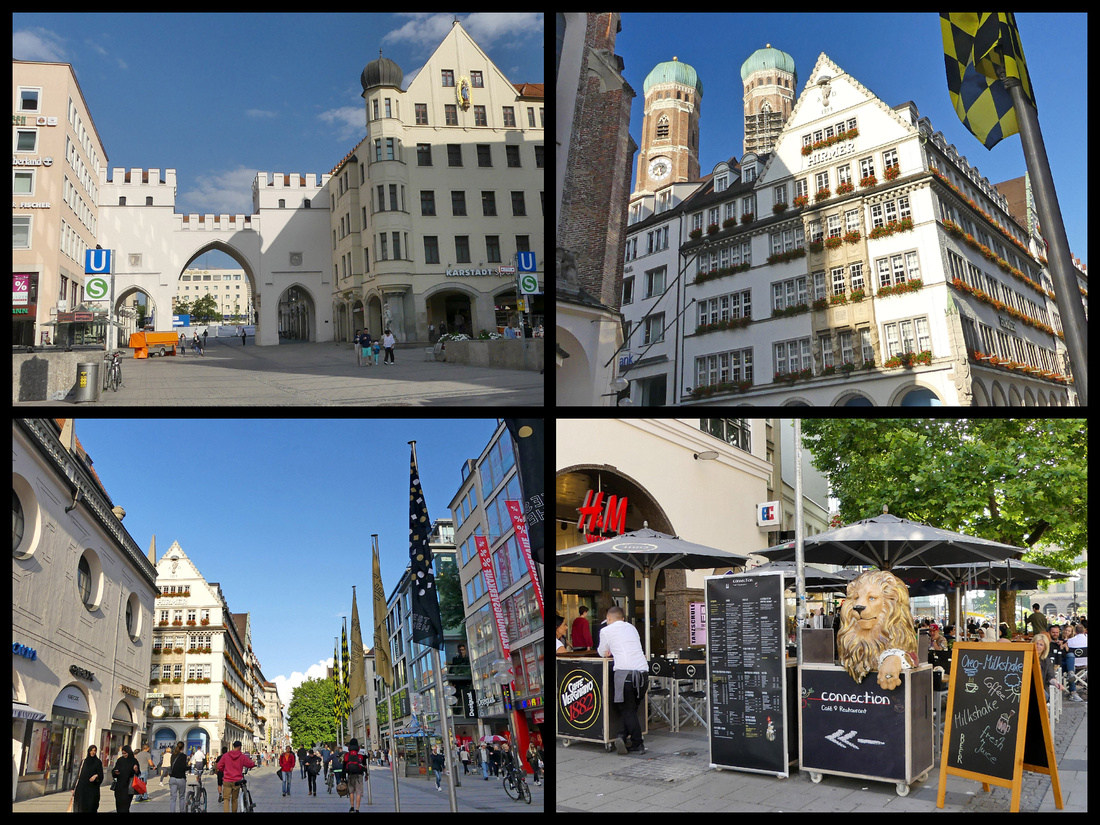

Marienplatz - with the New and Old Town Halls – is clearly the center of the action. The new town hall (Neues Rathaus ) built in the in the late 1800’s in the Flemish Gothic style, with a facade more than 90m (300 feet) long and featuring intricately carved stone. Inside are stained glass windows, vaulted ceilings, intricately carved wood working, and a labyrinth-patterned floor in the inner courtyard. Halfway up the center tower of the facade is a two-tier Glockenspiel, (Carillon) with 43 bells and 32 mechanical figures. The figures rotate accompanied by the music of the bells for about 15 minutes, several times a day. It is the largest in Germany and the 4th largest in Europe. The Old Town Hall (Altes Rathaus), at the end of Marienplatz, was built in 1470. The 55-meter-tall (180 foot) tower is visible from a number of spots in the city. The tower is actually older than the building proper as it was built in the 12th century as part of Munich's fortifications.
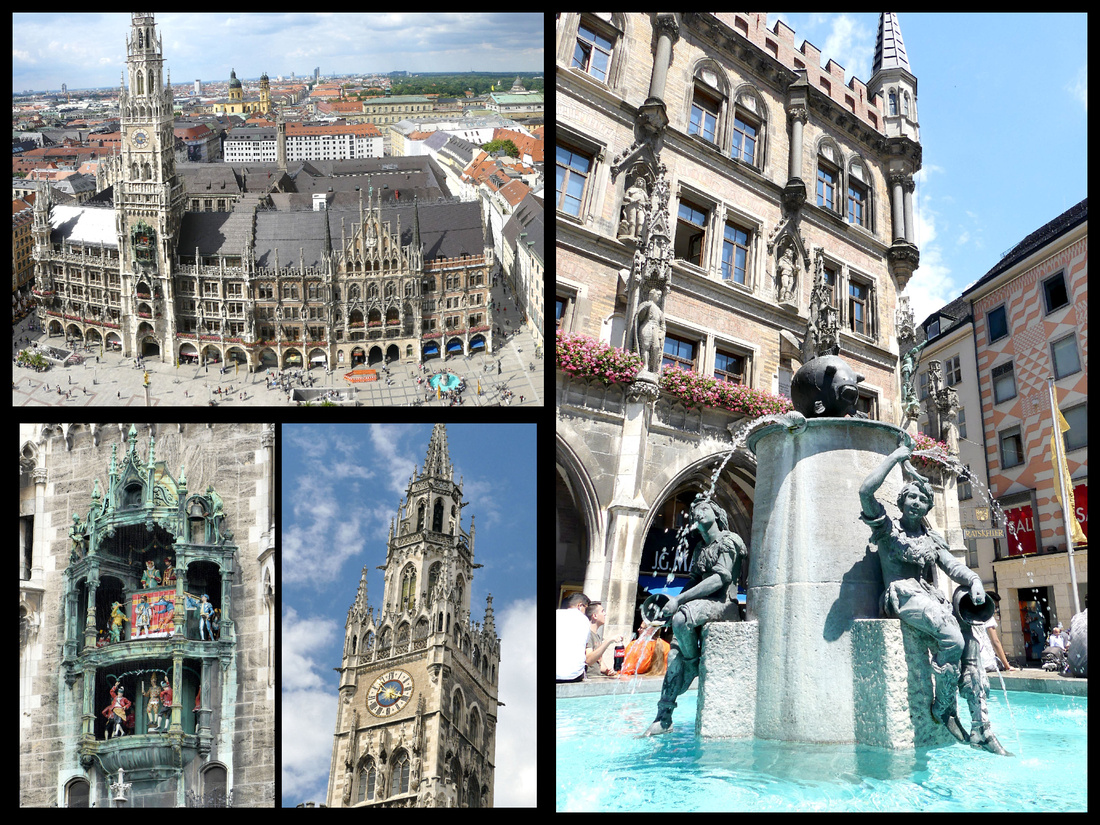

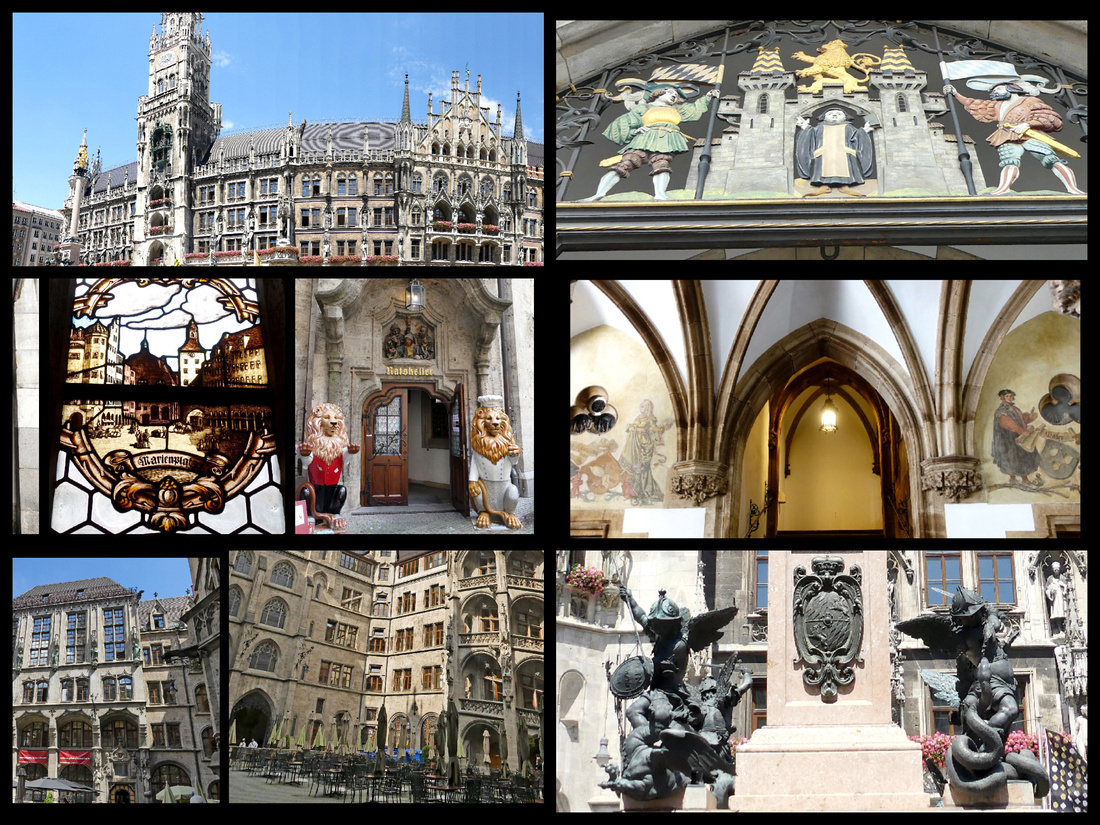

Above: Marienplatz and the Neues Rathaus The lower photos are of the courtyard.
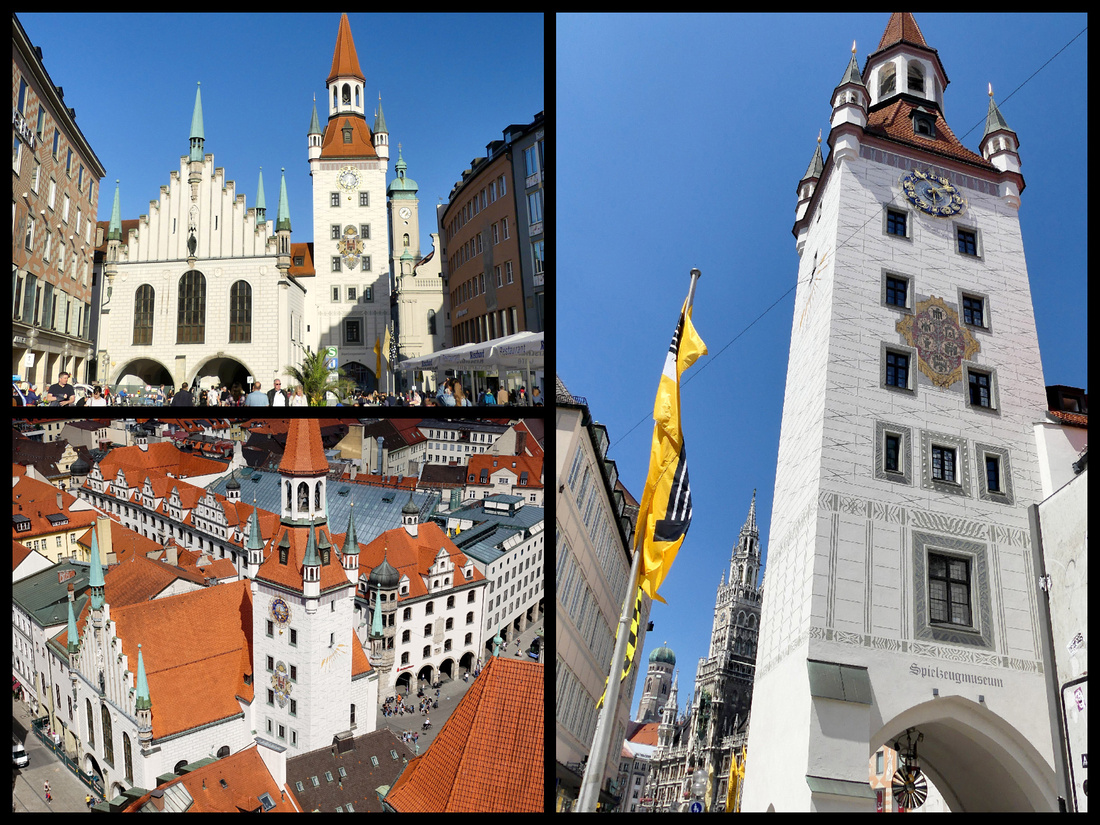
 Above: the Altes Rathaus
Above: the Altes Rathaus
Some towns in Germany (most of which were badly damaged in WWII) rebuilt in modern style (e.g. Frankfurt) but Munich chose to renovate and rebuild its old town center. There are many beautiful buildings, but they are interspersed with some more boring, mid 20th century stuff and this is evident in the buildings around Marienplatz.
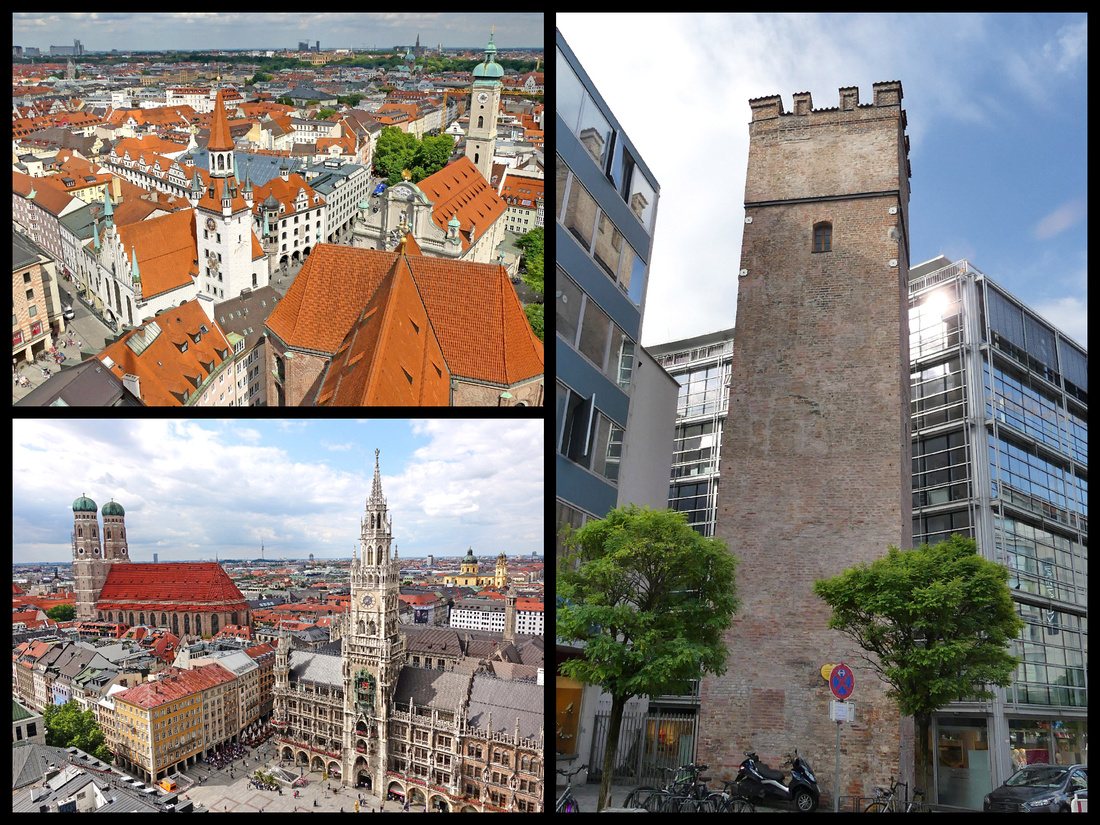

Upper left: Altes Rathaus at one end of Marienplatz from Peters-kirche tower Lower left: Neus Rathaus at the other end of Marienplatz and Frauen-kirche to the left of that. Right photo: the old and the new just off Marieplatz
We wandered around the Viktualien-markt but decided to go the Hofbrauhaus for lunch. The Hofbräuhaus – one of prettiest buildings and squares (Platzl) in Munich has been selling beer for over 400 years. It has four main areas. The Schwemme (taproom) is a huge room that was once used for beer production, but is now a beer-drinking hall seating 1,300 with beautifully decorated walls and ceilings. The Bräustüberl is a smaller room and the Festival Hall is a chandeliered room on the second floor which charges a cover but features live entertainment. Outside is the beer garden with shady chestnut trees.
We shared a table with a couple from Frankfurt, who spoke only marginal English (which was still way better than our German – but my husband did get to try out a few words). So we had a fun ‘conversation’ along with our bratwurst (grilled, pork sausage, served with mustard and sauerkraut) and some white sausage that is apparently the classic Munich sausage. It is veal and comes boiled which at first did not look that appetizing, but the mustard that came with it was really good (dark and sweet) so we actually liked that better. They pointed out the obvious that Germans are referred to as ‘krauts’ because of sauerkraut. My husband ordered a dark beer and I think it was the only one I saw, everyone else (hundreds of people) were drinking the light stuff.
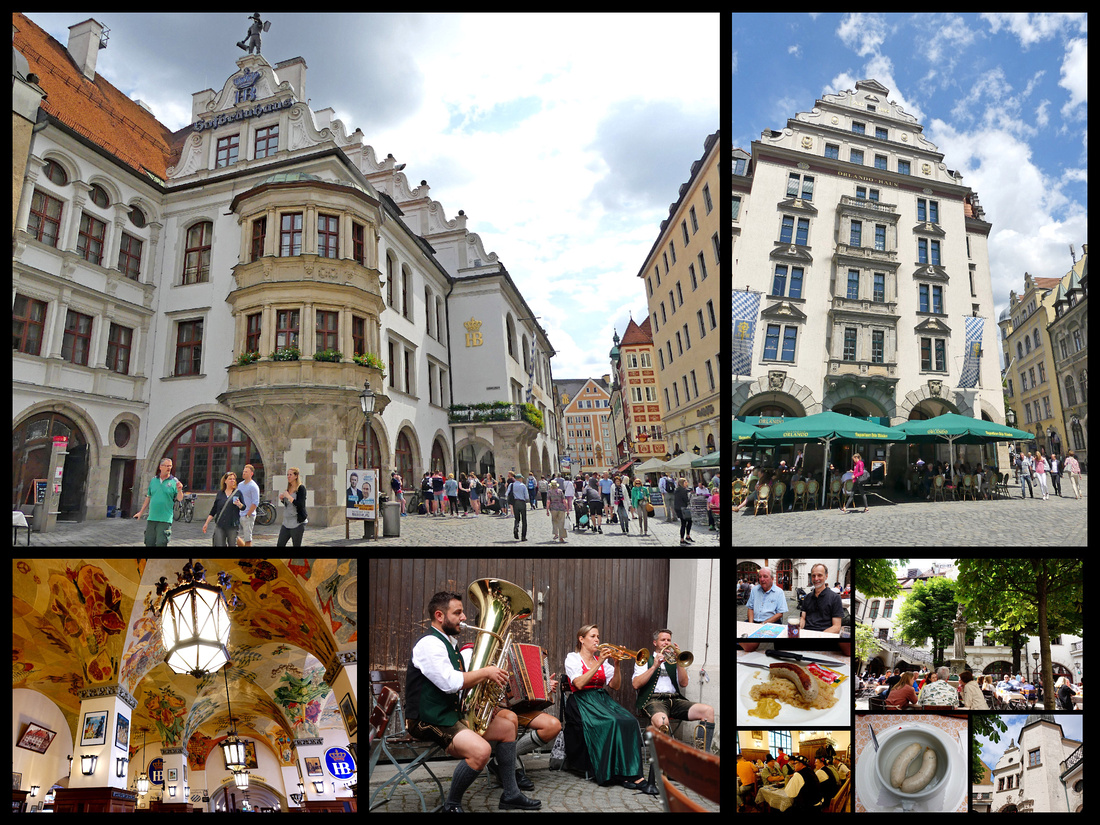

Viktuallienmarkt- a huge market with mostly permanent stalls selling all manner of food (bakeries, butchers, fruits and veggies, cheese, flowers, etc.) including prepared foods. In the center is a beer garden and you can get food at any of the stalls and bring it to the tables in the beer garden as long as you order a drink. The market has been there for 200 years and there is a large maypole in the center, which is painted in the Bavarian colors of blue and white. Maypoles were used in previous times to signify which crafts and industries are important to the local area. These emblems are still visible today on the Vikualienmarkt's maypole.
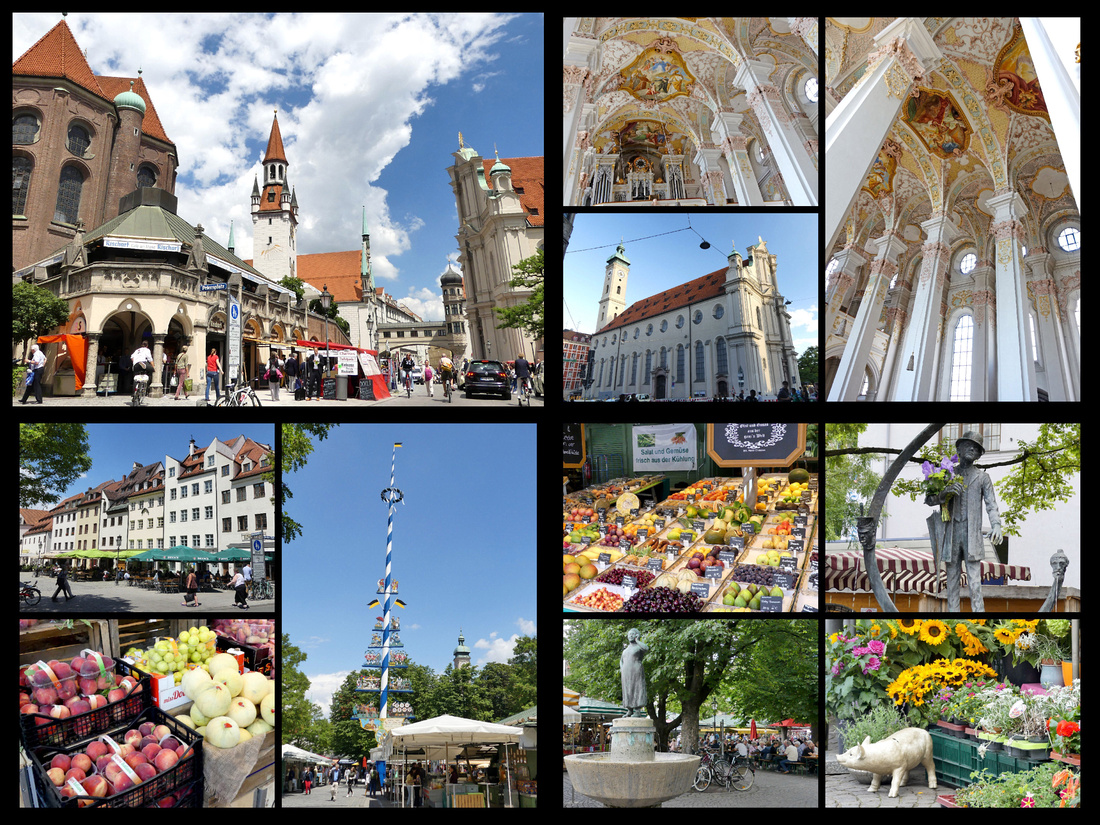

Upper left: Viktualienmark - one of the permanent market buildings with Peters-kirch to the left of it, Altes Rathaus directly behind it, and
Heiliggeist Church to the right of the photo. Upper right photos are of Heiliggeist Church including interior. Lower photos all of Viktualienmark.
Heiliggeist (Holy Ghost) Church sits between Marienplatz and Viktuallienmark. This Gothic "Hall Church" originally belonged to the 14th century Hospice of the Holy Ghost and while only ‘moderately’ pretty from the outside, has amazing baroque décor inside.
Just behind the market is Peters-kirche. It’s Munich’s oldest church, begun in 1181 but rebuilt numerous times in different architectural styles since then, today it is an elaborate Rococo / "Bavarian Baroque" style. The most interesting thing inside is the bizarre gem studded skeleton (of St Muundita). The view from the tower (307 steps, €3) is probably the best in the city. It is a pretty narrow stairway but there are numerous landings where you can ‘pull over’ to let people going in the other direction pass. I had read that it was ‘scary and unsafe’ and so crowded at the viewing platform that it was not worth doing, but I didn’t find it any more crowded than most towers (and I climb a lot of them). The views certainly made it worthwhile.
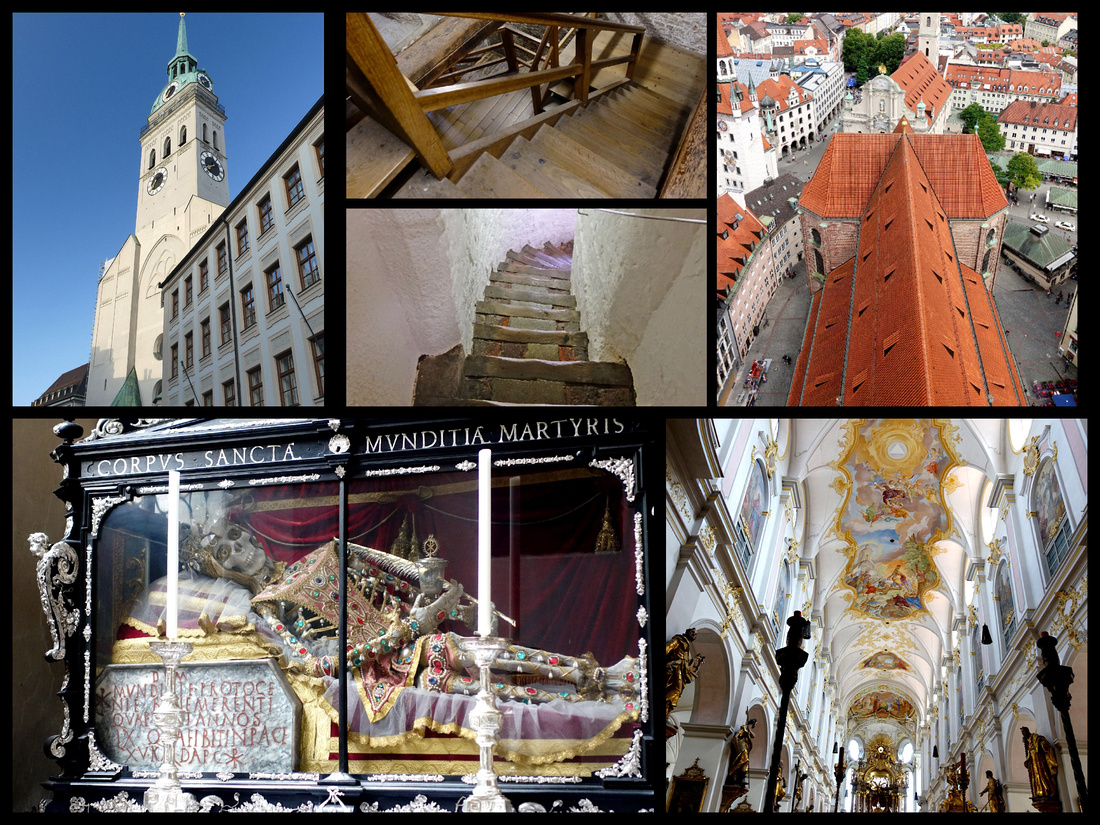

We wandered around the Allstadt as far as the Residenz (on Max-Joseph Platz) and National Theater – reasonably impressive but nowhere near the top of ‘impressive palaces and theaters in Europe’. Just down the street, the Theatiner-kirche and Odeonsplatz were much better. For one thing the church is bright yellow and the Odeon is an Italian style loggia with two nice big lions guarding the steps into it, and another nice lion inside. There were also lions all along the side of the Residenz which, takes up the entire block between the two squares. Then we checked out the Hofgarten – tiny but with a nice little rotunda (with two guys playing violin) and several fountains and manicured flowerbeds.

 Above - Lower left: the Residenz and National Theater Other photos: the Odeon and Theatiner-kirche
Above - Lower left: the Residenz and National Theater Other photos: the Odeon and Theatiner-kirche
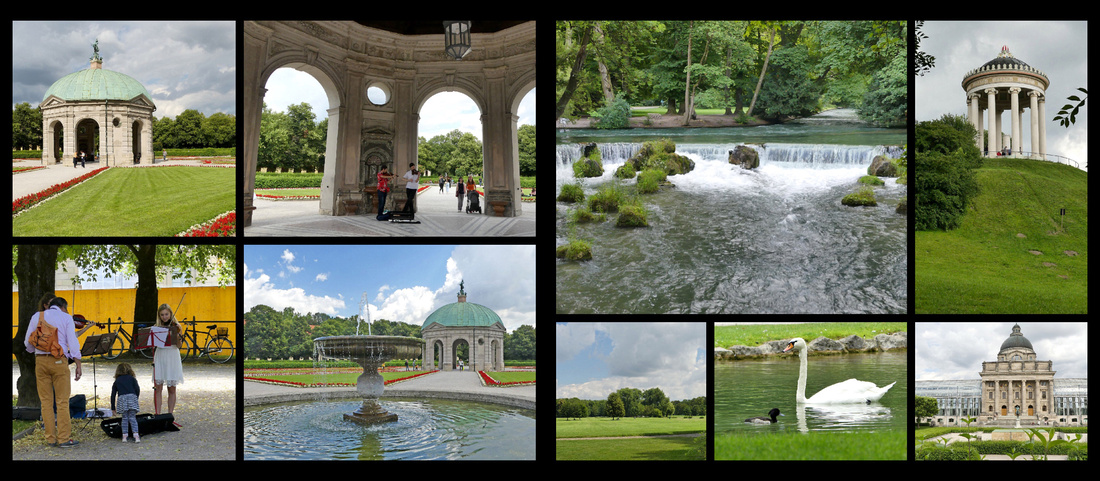

Above - Left photos: Hofgarten Right photos: Englischer Garten
The following morning we headed out to explore Munich in the sunshine (throughout the day it was sunny, cloudy, rained, repeat – quite cool, in jeans and a tee shirt I was alternately too warm and too cool). Central Munich is small enough to easily cover in a day (we felt a day and a half were just about right) – we explored churches, markets, gates and gardens.
Munich was originally protected by a city wall with nine gates, three of which still remain. Karlstor, originally had three towers, but the tallest, central tower was destroyed in 1857 when the gunpowder that was stored in the tower exploded. The two side towers were renovated in 1861 in a neo-gothic design. It’s through Karlstor that the main pedestrian shopping street leading to Marienplatz begins. Sendlinger Tor is the oldest remaining gate, built in 1318 as the entrance leading into the city from Italy. The tall central tower was demolished in 1808 and in 1906 the three arches that connected the two outer towers were replaced by a single, large arch, enabling cars to pass through the gate. At the same time two smaller gates were created in the hexagonal towers for the pedestrians. To the west of the city center is Isartor. The central tower was built in 1337 and gave entrance to the Isar, the river flowing through Munich. The smaller, octagonal towers were built in the 15th century. The facade of the Isartor is decorated with murals depicting a triumphal procession in 1322.


Above - Upper left: Asam Chlurch Upper Right: Sendlinger Tor Lower left: Isartor Lower right: Karlstor
Near the Sendlinger Tor is the Asam Church, very tiny and very rococo, but much darker inside than most rococo churches, it was built by two brothers as their private church without an official order. It ranks among the finest Rococo style churches in the world but it was too dark and too ‘busy’ for my taste.
Right on the main pedestrian street is Michaels-kirche, the largest Renaissance church north of the Alps. Built 1583-1597 for the Jesuits as a symbol to the Counter-Reformation's triumph over north German Lutheranism. The barrel vault inside spans 20 meters and is the second largest in the world after St. Peter's in Rome. The facade is graced with a large bronze sculpture of the Archangel Michael, 1588.
Just behind that is the Frauen-kirche. The twin onion domes were the inspiration for the characteristic domed church spires marking villages throughout Bavaria. Although much of the church was destroyed during World War II, the towers survived, the church was originally built in 1468-88, the domes added 1525. By law no other tower can be taller or obstruct the view of this symbolic Bavarian building.
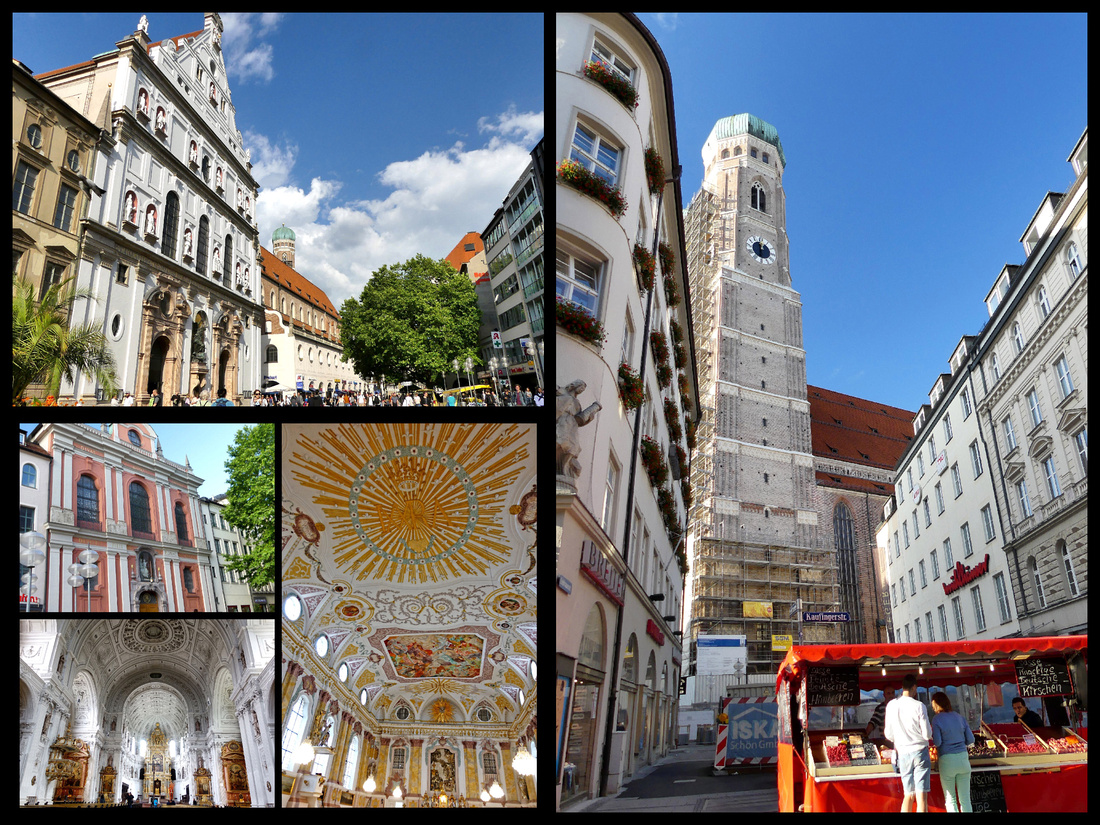

Throughout the center of Munich are several small squares, two of the prettiest are Alter Hof (1253) and Munzhof. Built between 1563 and 1567, this building has housed the imperial stables, the first museum north of the Alps, and a branch of the government mint. Today, it's headquarters for Munich's Landmark Preservation office. It’s connected to the Alter Hof by a covered arch.
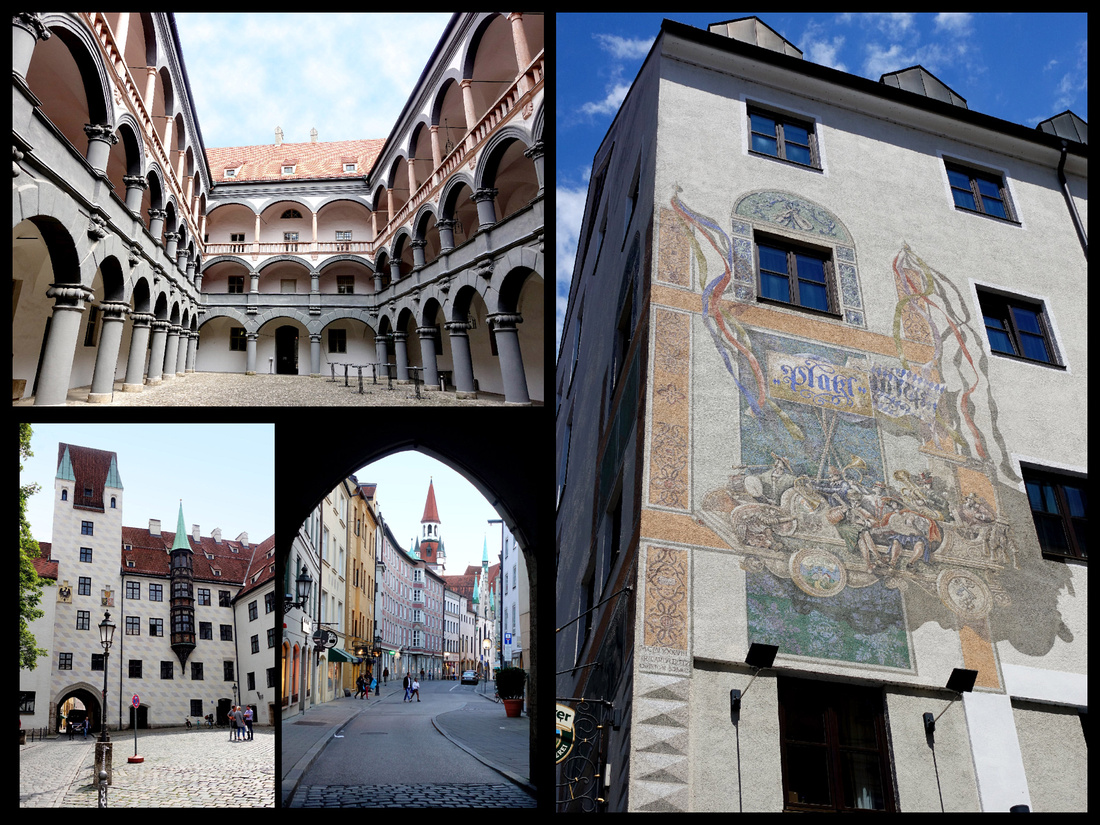

On the other side of town is the Englischer Garten – the largest city park in Europe (so they say), bigger than Central Park. Don’t know cause we only did the lower half, and it was a good mile or more but somehow didn’t feel like it was on a scope with Central Park. Lot’s less ‘stuff’. There is an interesting very fast flowing river – not sure how it flows that fast in such a flat city, but in parts it’s fast enough that there are actual waves and guys surfing. Also a nice little waterfall, some swans, lots of tree shaded paths and large lawns. About half way in is a Japanese pagoda (large size, but all wood, not painted) surrounded by a large beer garden (also numerous kiosks serving food, was too early for lunch but looked like it would be good).
Our last day in Munich was cold and rainy - so possible day trips we had considered were not going to be worth it. However the Deutches Museum and the July sales kept us busy.
HALLSTATT
Days 4-5 - We traveled from Munich to Hallstatt. The first leg was the 7:51train to Salzburg where we had about ten minutes to change trains and even though the Salzburg station is large (and modern and nicer than Munich’s) the train was on time and the platforms well marked so no problem. Then we had to change in a smaller town and 6 of our 11 minutes were taken up with the train being late. No time to dawdle but we made the connection with about 2 minute to spare. Arrived in Hallstatt on time and followed the crowd to the waiting ferry, “The Stephanie”, for the five minute crossing ($2.50 each way). Hallstatt is located on the west bank of the Hallstätter See (Lake Hallstatt), a UNESCO World Heritage site, while trains run on the east bank only. Hallstatt train station (Bahnhof) is thus on the “wrong” side of the lake. This boat ride would probably be gorgeous in nice weather, and was even pretty in the clouds and drizzle. (As was the scenery on the train). The maps of Hallstatt (on line and posted on signs) are not that great but there’s really only a few streets and we headed away from the ferry and through the central square, kept following the road which hugs the lake. By then it was really raining fairly hard but nothing to do but keep going. It was at least a 10-15 minute walk but when we saw signs for the funicular I knew it was close. From the funicular station it’s just about a block to the hotel, Gasthof Gruner Anger.
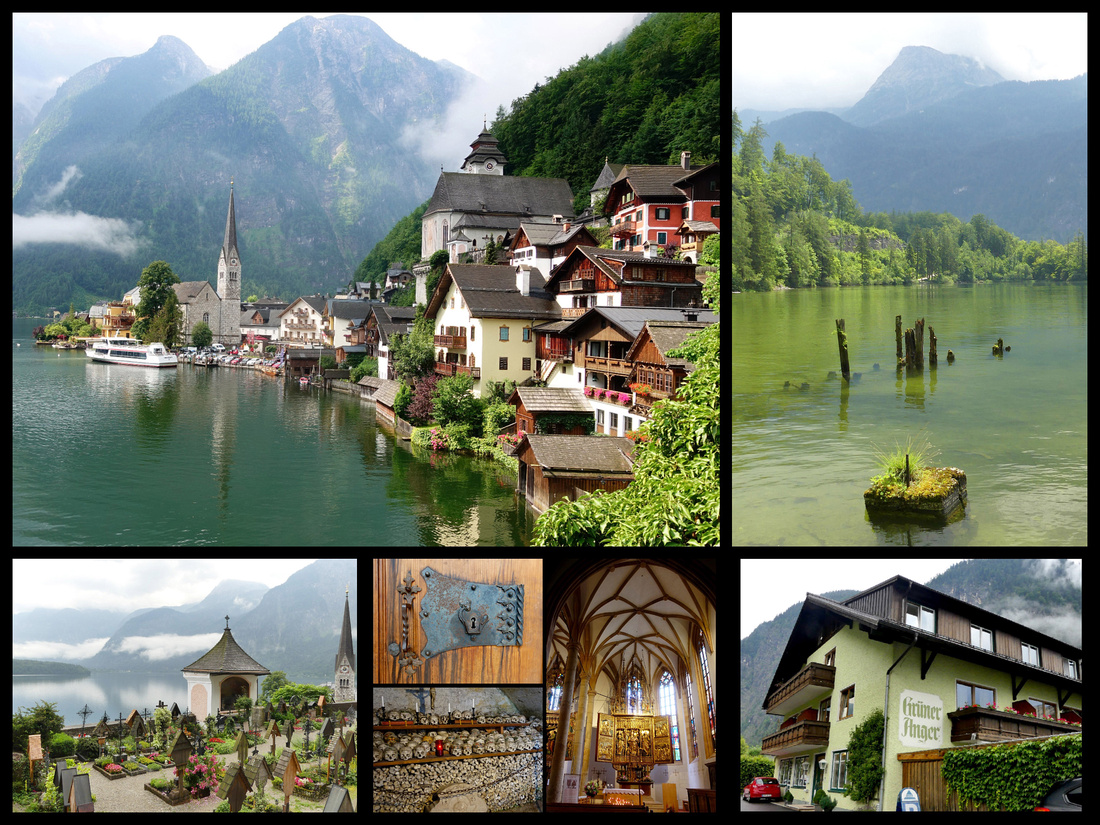

Gasthof Gruner Anger is pleasant enough – looks like every other house in town. It was about 1:45pm and the room wasn’t ready but we were not about to go out walking around in the pouring rain so we sat and had a beer till the room was ready around 2:30. Pretty large room, big bathroom, every thing relatively new, fast Wi-Fi. There isn’t a ‘restaurant’ but guests can have dinner if you tell the host by 4pm, choice of pork or fish. So we ordered dinner, which is served at 6pm. It was quite good, came with soup, salad and desert for €14 each, drinks extra.
Hallstatt is the oldest still-inhabited village in Europe, owing its longevity to the local deposits of salt. Between it’s history and setting it is on the UNESCO list. It is very scenic, even on a cloudy day. There were a lot of people, but I wouldn’t say it was mobbed, perhaps the rain kept the crowds down (I don’t know, where do tour buses go when it rains?). Asian’s outnumbering everyone else by about 10 to one. According to our hotel host, Hallstatt has become so popular with Chinese that someone in China built a complete replica of the town, which has served to make it even more popular.
We walked the length of town – if you just strolled and didn’t stop to take photos it would take maybe half hour tops. We looked in both churches and climbed a ways up the hill – to what turned out to be a parking lot with a view. Apparently there is a highway that goes through the mountains just above the town. There is also a pretty significant waterfall right in the middle of town, the best view of which is from said parking lot.
The following morning it was still drizzly. At 9 am the town was almost deserted, by 10 am there were a good number of people but still not oppressive, by 11 it was crowded. We wandered around to the various viewpoints at each end of town. Decided it was too cloudy to make it worth the money to take the funicular up.
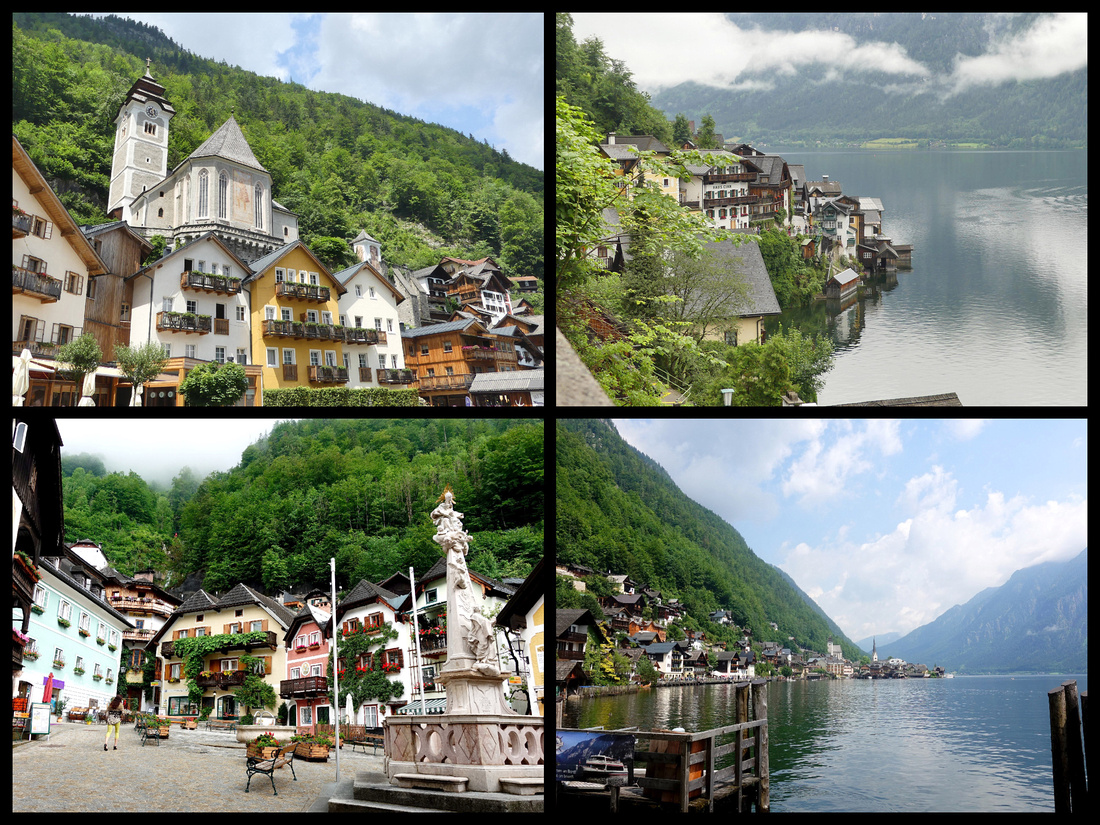

All in all Hallstatt is certainly a very pretty town in a beautiful setting. But you can walk from one end to the other in half an hour, the shops are all just touristy crap. Even the paths up the hill above town are not that great – the mountains coming down to the lake are very pretty but the town from above is not all that striking – best views are from one side or the other, from within and from above not so much. You could do the salt mine, or rent little boats and tool around the lake but neither of those really enticed us. Twenty-four hours was more than enough. But I think it was the right decision for us to do a one-nighter there, thus being there before and after the tour groups.
So onward to Graz. Our first train was 8 minutes late pulling into Hallstatt and we only had a 6 minute connection so we were sure we’d miss it but just as we were pulling in to the station where our connection was, so was our next train – we literally ran across the platform and hopped on.
Hotel Daniel in Graz is right on the train station square – a boring square with about 5 large hotels and nothing else. There is a Spar grocery store next to the train station. The hotel is 6 stories, modern and recently updated (says it’s been there since 1886 but must have been a different building as this one looks mid 20th century). Inside it’s pretty swanky, decent sized room, spotless, lift, AC, free fast internet. The only problem, and I think it’s pretty significant, is that the shower is literally 15 inches from the bed and there is just a glass wall. Seriously, who wants to watch someone else shower. It would be really creepy if it was two friends rather than a couple sharing the room. And at €112 a night it seems a bit steep for a ‘non-major’ city. Breakfast was €13 per person so we didn’t get that, but there were plenty of cafes next door in the train station.The hotel is about 3/4 mile (15 minute walk) from the river and the start of the old town. Boring but otherwise fine.
We wandered around, had dinner in a small restaurant in a courtyard just off one of the main streets. There were several musicians playing in different locations, a ‘summer vegan festival’ in one square. Nice enough vibe. Reminded me a little of Ljubljana but not quite as nice.
Days 6-7 We spent two days just exploring Graz. The main squares and buildings on the main streets of Graz are really nice – it’s a UNESCO site after all. “A harmonious blend of architectural styles and artistic movements that have succeeded each other from the Middle Ages until the 18th century, from the many neighboring regions of Central and Mediterranean Europe.” The main streets seem to be mostly car free – though the trams go through them.
Hauptplatz (Main Square), is the heart of the city, surrounded by ancient houses with characteristic red-tile roofs and narrow gables. The most notable house is the House of Luegg at the corner of Sporgasse, known for its arcades and facade dating from the 17th century. The town hall is the largest and most impressive building on the square. Herrengasse, is the main shopping street leading off from the square. The most interesting building in the city is the Landhaus, just off the main square. A 1557 Renaissance masterpiece, reminiscent of a Venetian palazzo. Supposedly the finest Renaissance building north of the Alps and I believe that. I had read that there are concerts there and sure enough, a free orchestra was performing the evening we arrived. Almost across the street on Herrengasse is the “Painted House” featuring Greek and Roman gods. It was first painted in 1600 but most of what is visible now is from 1742.


Above - Hauptplatz Top Right: town hall




Above - Landhaus
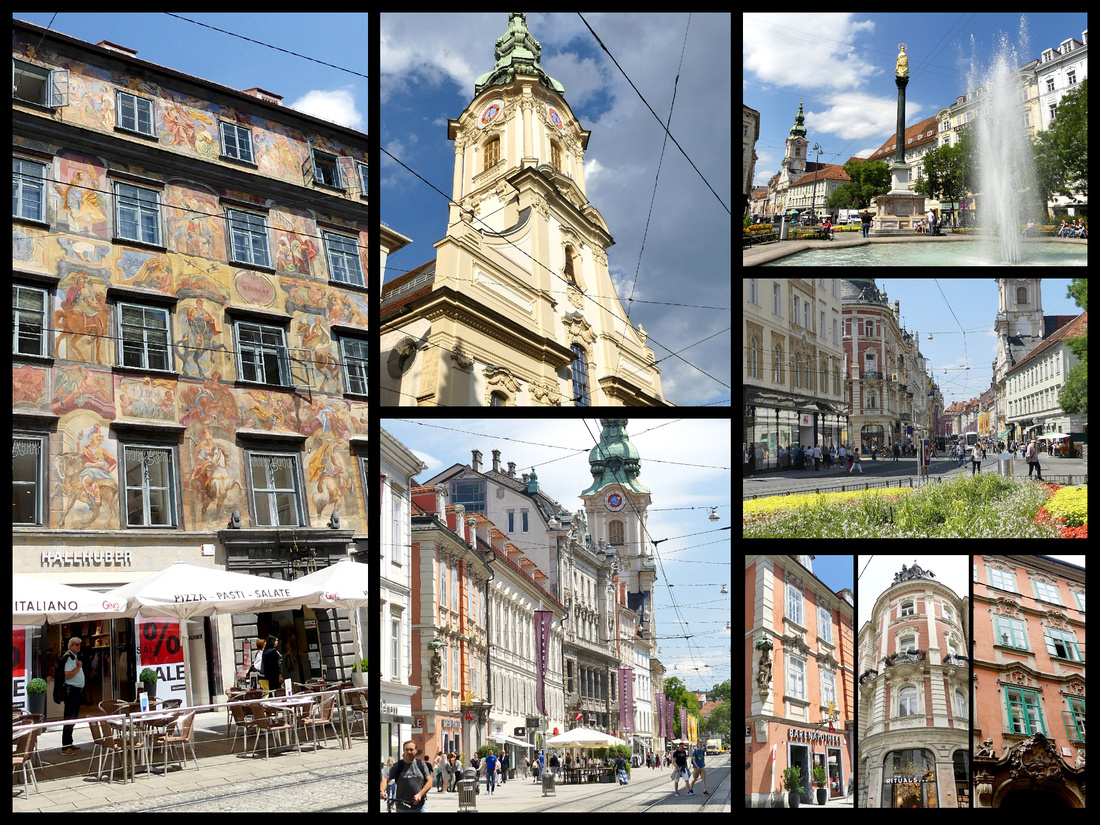

A few atmospheric side streets lead to Glockenspielplatz, one of the prettiest squares in the city and featuring an 1884 Glockenspeil.
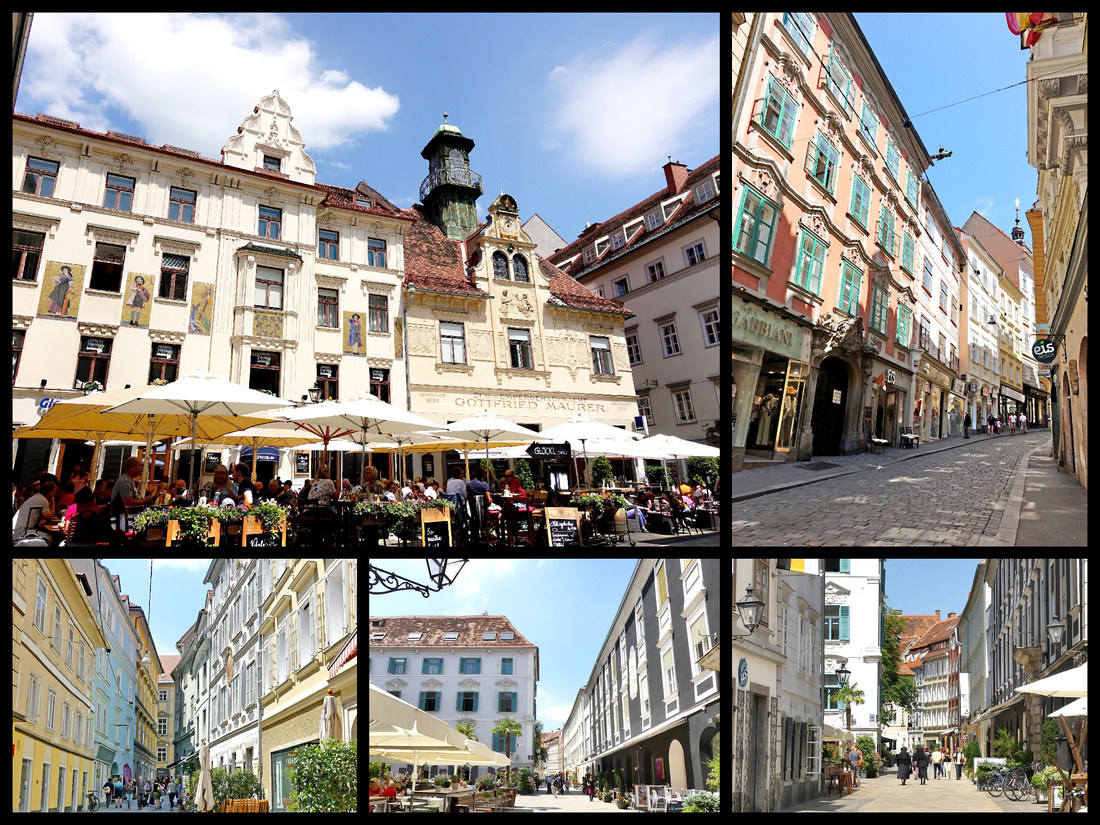

Graz’s cathedral/Dom, St Giles, I didn’t think was particularly impressive, but right next to it is the Mausoleum and the turquoise domes of the church and mausoleum together make a nice site.


But even more interesting across the street is the Hofburg (all residences of the Habsburgs were called “Hofburg”. The burg itself is pretty plain (nothing ‘castle’ like about it) and if there was a way to tour the interior we didn’t find it. But it’s main feature, a double spiral staircase we did find. If you like stone spiral staircases this one is a stunner. Just behind it is a small but pleasant city park with duck pond and some statuary.
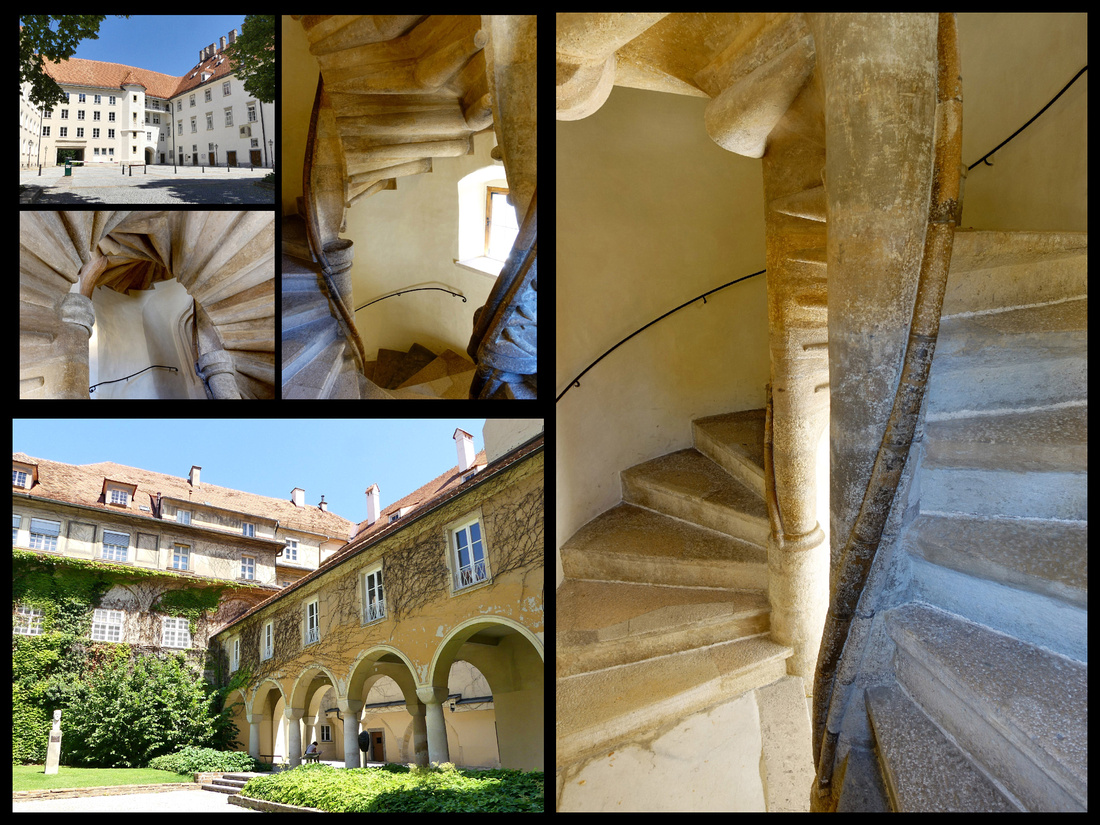

Probably the most noticeable feature of Graz is the Schlossburg, up on a hill in the center of town. There is only a small part of the original fortress, but the 16th century clock/bell tower remains and there is now a lovely park around it with a beer garden and the few remains of the fortress itself. The views are pretty good.
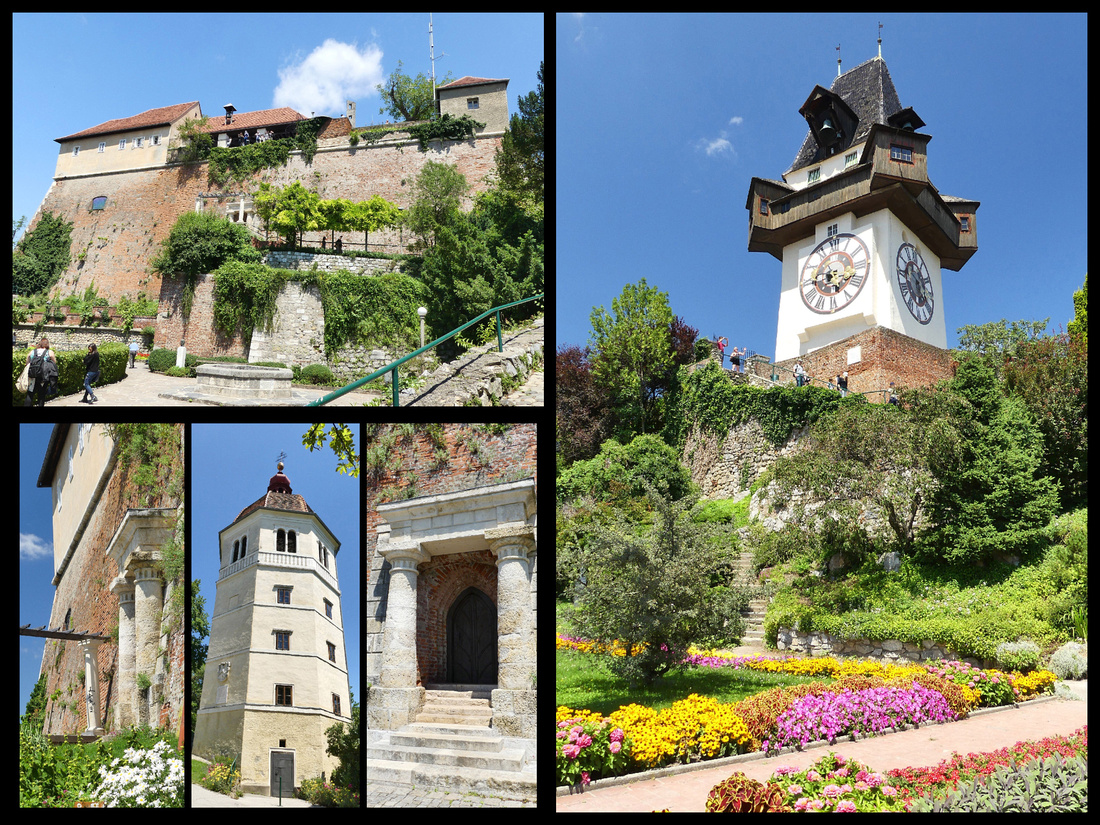

The Mur river runs through Graz, just outside the main part of the old town and there is an interesting ‘thing’ in the middle of it. I guess you could describe it as a footbridge with a man made glass island in the center with a café. Definitely unusual. And just past that on the other side of the river is the Kunsthaus, an art museum in a building, referred to as the ‘friendly alien’ which looks kind of like a blue glass balloon. Very interesting contrast to the surrounding neighborhood of old gabled buildings and square.
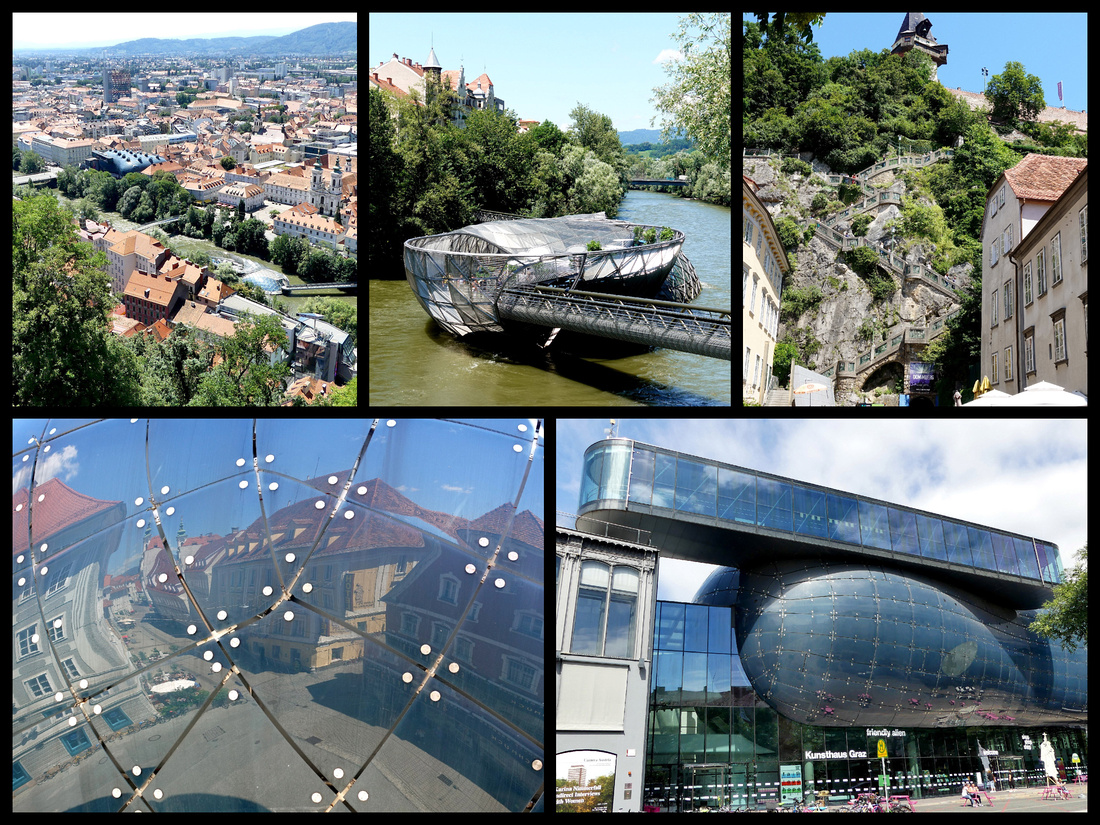

There were numerous other squares and neighborhoods and several nice churches.


I would say Graz can definitely be ‘seen’ in a day or day and a half. If you wanted to do Eggenburg Palace and the armory museum that would take another half day – unfortunately both closed on Monday so we didn’t get to them. I wouldn’t say I was disappointed with Graz, I love most old European cities, but I certainly wouldn’t suggest someone go there instead of Saltzburg or Vienna. Since I had been to both of them previously, visiting Graz was a good decision for this trip.
BRATISLAVA
Days 8-10: Bratislava - Bratislava train station is about 20 minute walk to St Michael’s gate and APLEND CITY Hotel Michalsk , Bastova 4 is just around the corner from the gate. One of the nicest little lanes in town and we got upgraded to an apartment – huge, two big rooms, full kitchen, spotless, really comfortable. Right next door to the hotel itself. So don’t know how the rooms there are but the apartment is fabulous. And we got breakfast – not sure if it goes with the apt. or if we got it cause we had booked a regular room.

 Above - Top Left: St Michael's Tower from Michalska (street leading to it from center of old town) Top Right: alley just to the left of the gate where hotel is located.
Above - Top Left: St Michael's Tower from Michalska (street leading to it from center of old town) Top Right: alley just to the left of the gate where hotel is located.
Bratislava’s compact old town has been completely and beautifully renovated and most of it is car free. It’s much smaller than I expected (the city’s population is close to half a million, and while most old European city’s old towns are pretty compact, this seemed much smaller than most). Similar to – but not as picturesque or interesting as – Prague, Krakow, Tallinn. But so small, without stopping you can literally walk across it in ten minutes. Easy to cover the entire area, including all the side streets, in a few hours. The castle on the hill is a nice touch but more scenic from a distance. Surrounding the old town is a massive area of Communist era concrete apartments but you really don’t notice them at all while in the old town. It’s a relaxing little city with a nice setting on the Danube, with plenty of picturesque squares and side streets to explore, and lots of reasonably priced restaurants with “Slovakian” food (as well as an assortment of Scottish, Irish and Mexican). The 'best' thing in town is St. Michael's Tower (Michalska veza). It serves as the entryway into the Old Town and is actually part of the city's medieval fortification system.
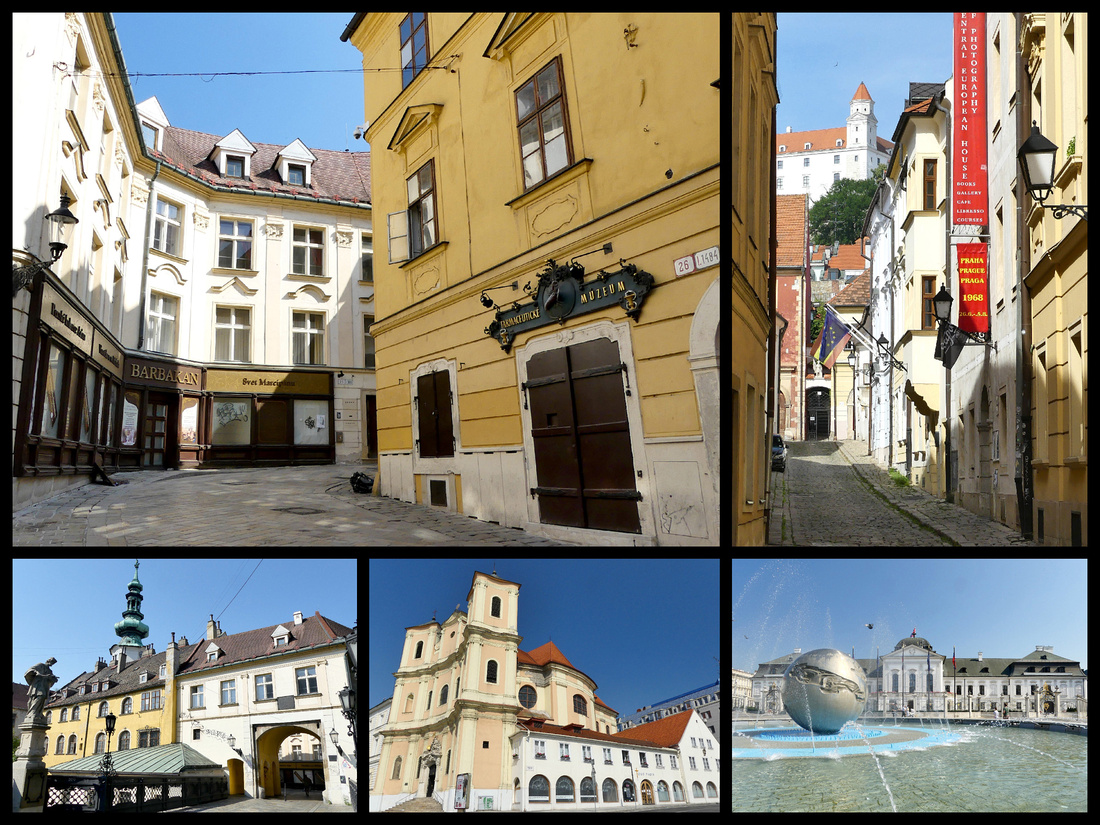

Above - top left: area just inside St Michael's gate, bottom left: entrance to St Michael's gate from outside
lower center: Church just outside St Michaels's gate, lower right: Bratislava's president's house a few blocks from St Michael's gate
The main square, Hlavné námestie, is small but in addition to a large fountain and the huge clock tower of the town hall, has a number of buildings from various eras; Gothic, Baroque, Renaissance, as well as art nouveau. The Old Town Hall/ Altes Rathaus is a beautiful yellow building with a pretty courtyard and a gorgeous clock tower (can climb it for €2.50) for nice view of the old town and the castle as well as the Danube.


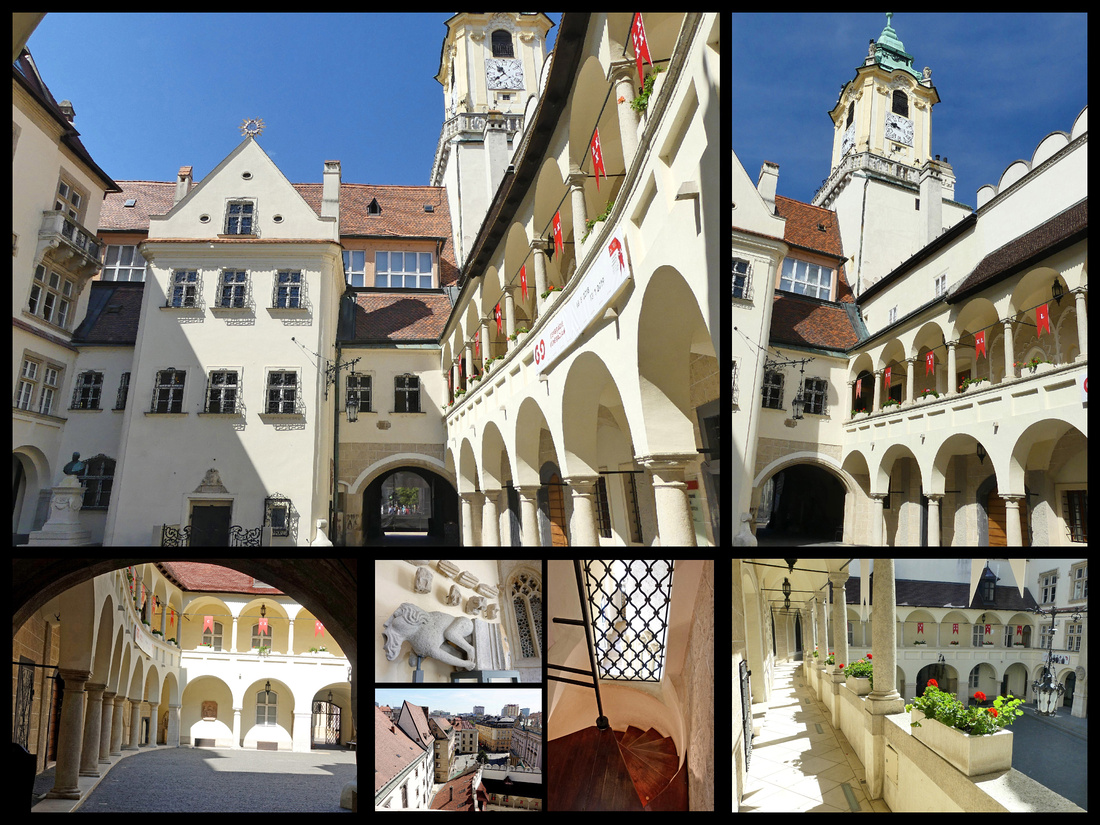
 Above - The courtyard of the town hall
Above - The courtyard of the town hall
On the other side of the Town hall is the Primate's Palace (Primaciálny Palác), a very pretty pink building, that is now the home of the mayor.


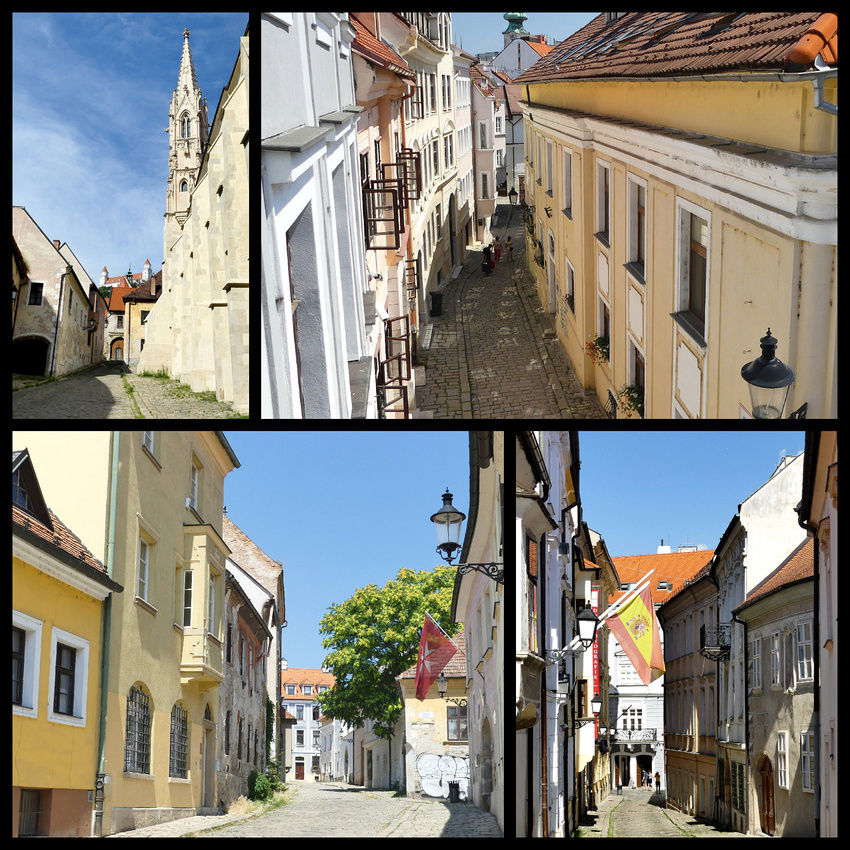



Above - upper left: main street leading to St. Michael's tower upper right: Opera House
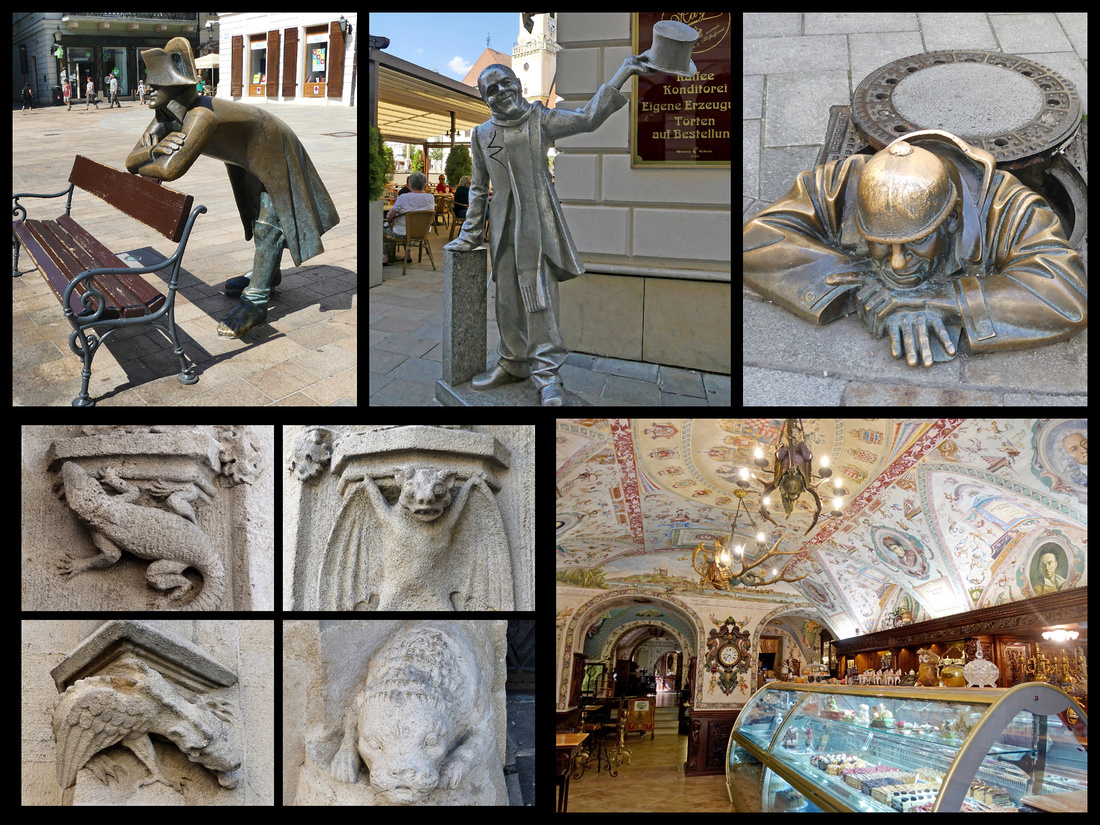

Upper photos: three of the most interesting bronze statues scattered throughout Bratislava Lower left: sculptures from the old Town Hall
Lower right: interior of cafe just off the main square
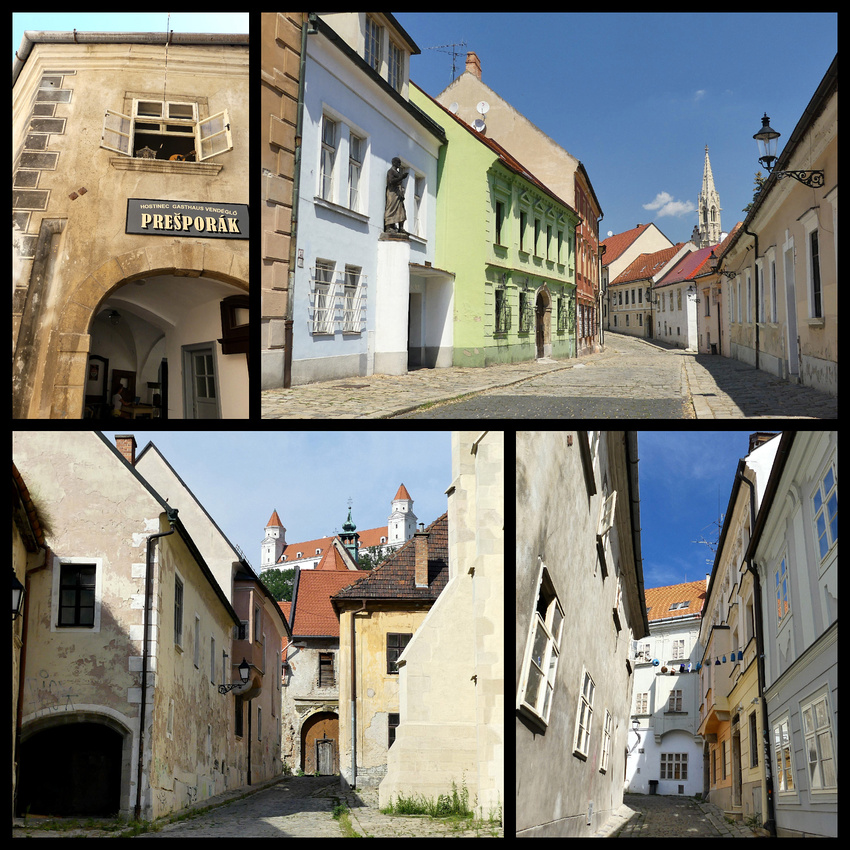

There is one small area of town walls remaining between there and the cathedral, opposite the castle. There was an interesting exhibit about WW II in one section. The castle itself is across the main highway (built in communist times, it goes right smack in front of the cathedral, done on purpose to diminish the importance of the 'church'). There are both under and over passes to get from the old town side to the castle side. One of the most interesting buildings in town is just below the steps up to the castle, opposite the cathedral. It's the House of the Good Shepherd, a very narrow Rococo style building, built in 1760.
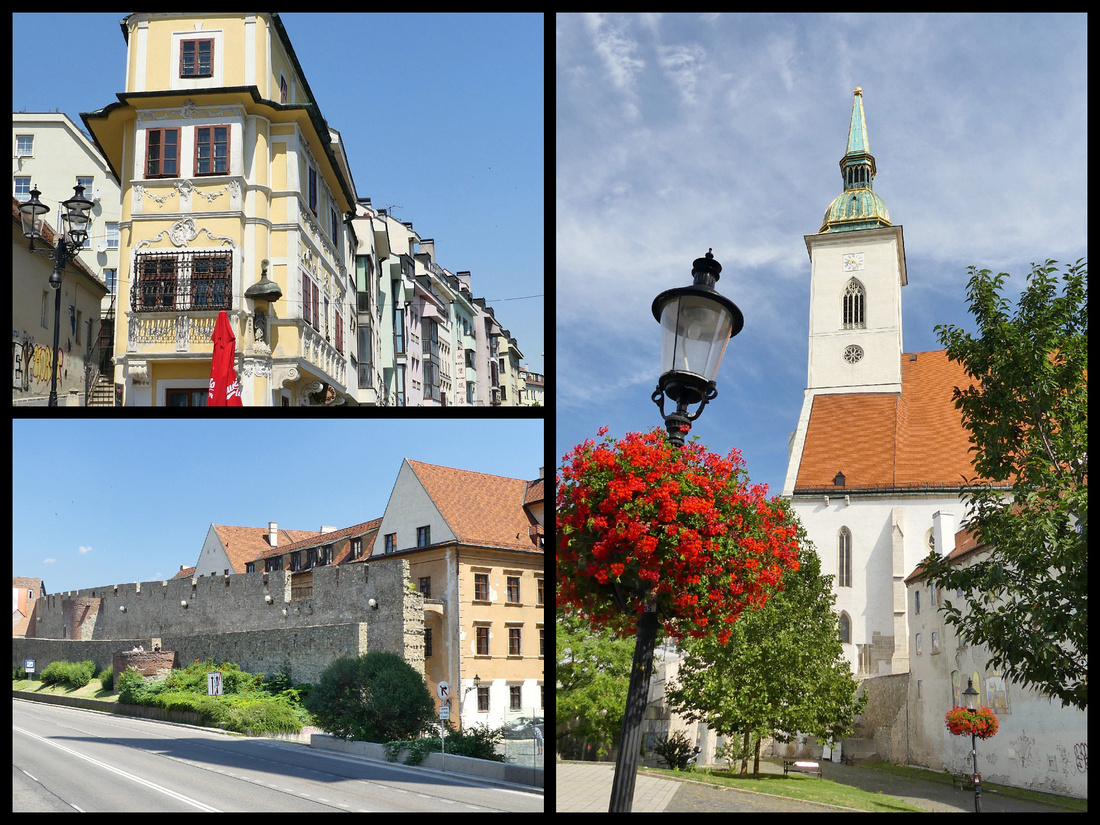

Bratislava castle – We also walked up to the castle – certainly a climb but took all of 15 minutes. You can see forever but the 20th century buildings are right up close to the old town so not that picturesque. But the Danube is pretty (though much more green than blue). Great view of the thousands of communist era apartment blocks that surround the city. Reviews of the interior of the castle were disappointing so we just walked through the grounds and gardens. More good views of the 1960s space age tower (UFO) just across the river is interesting.


The “Blue Church” is Bratislava’s most appealing art nouveau building (1913). Its style, sometimes known as Hungarian Secession, is repeated in the nearby grammar school on Grösslingová Street. Both the interior and exterior of the church are painted in shades of pale blue and decorated with blue majolica; even the roof is tiled with blue-glazed ceramics.


10 km west of the city center, Devín Castle is built on the top of a high crag, it towers over the small village of Devín and the confluence of the Danube and the Morava rivers, which form the border with Austria. Up till 1989 the Iron Curtain was drawn below the Castle, lined with barbed wire. Much of the literature (and the lady in the TI) said take bus 28, but when we went to buy tickets (from a kiosk, under the bridge just before the Bratislava castle ) the guy told us to get bus 29. So we did, comes every 20 minutes and takes about 20 minutes (.90€ pp each way, buy round trip as there is no where to get the return tickets in Devin). You could see the castle, and the stop was marked Devin Hrad. Ten minute walk to the entrance, another 10 after you buy your tickets (€5). Very nice ruins on top of a hill with a gorgeous view of the Danube – also the Morava as it joins the Danube. Also you can see 3 countries: Slovakia, Austria and Hungary. Spent about 1½ hours climbing various parts.
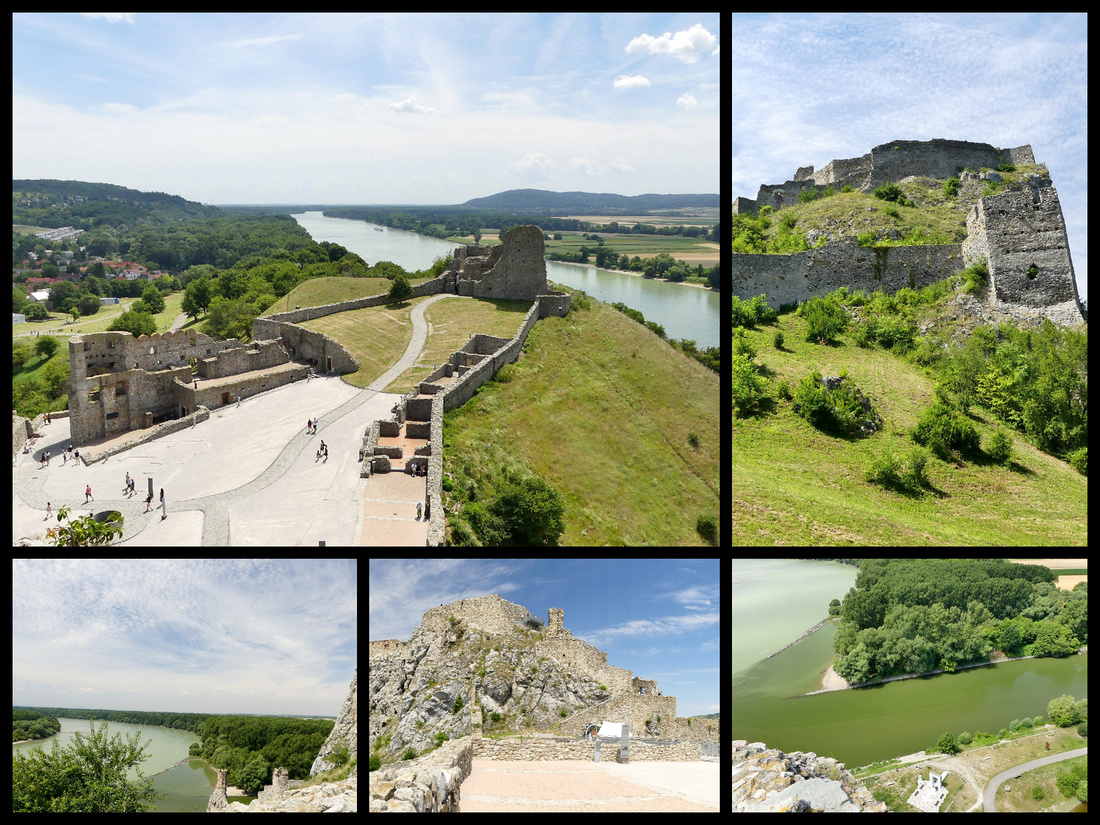

Tons of river cruises stop in Bratislava (one day I counted 12, they were even ‘double parked’). So there were plenty of tour groups wandering around, but overall it was not clogged with tourists and the whole center being car free was really nice. The one thing it lacked was interesting shops. Can’t remember any other city with so few stores selling anything at all I was interested in. The tourists shops sold nothing but junk and there were almost no other stores in the center. Although the major ‘attraction’ to Bratislava is it’s old town center, there is also a lovely riverside promenade (part of a 10 K walk that goes across the river to the other side and back) that leads to an area of modern glass buildings including one of the nicest malls I’ve seen (Eurovea Mall)– totally glass roof, interesting bronze statues scattered around, nice fountain out front and right on the river – with tons of cafes and bars along the riverfront. Across the Danube is a huge communist era apartment sprawl that apparently houses two hundred thousand people. Had no desire to explore it but interesting to think about what the city must have been like in those days.
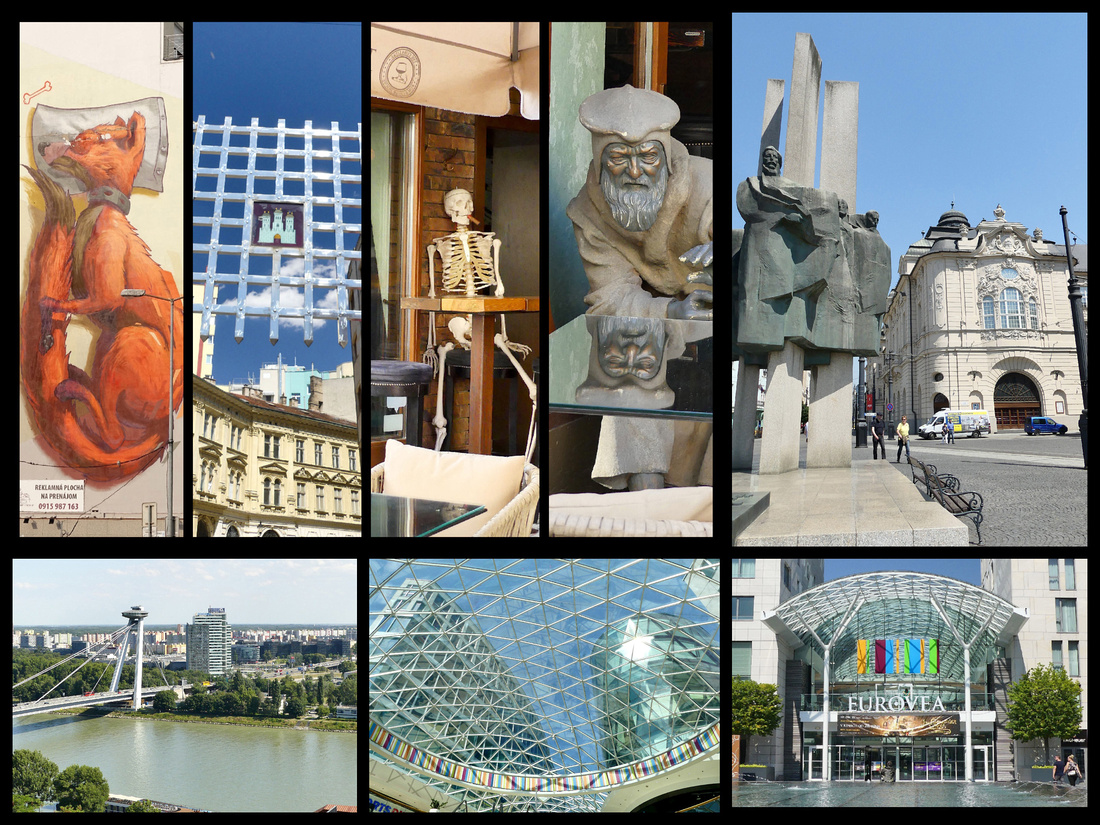

Above - upper photos: various scenes from Bratislava. Lower left: the retro-futuristic SNP Bridge which was built in the late 1960s at the height of Communist excess, inspired by optimistic futurism and looks like it sprang right out of an episode of Star Trek or The Jetsons. Lower center and right: the Eurovea Mall.
When trying to decide how many nights for Bratislava I asked the question on Fodors and got everything from ‘just do a day trip from Vienna’ to ‘you could be happy with three days’. Well my now ‘expert’ opinion is that a day trip would be ‘ok’ – you really can see the whole old town in a few hours, and while pleasant after dark it’s not that special that you need an overnight. However one night (with several hours each day) would be fine and two nights would allow for the visit to Devin – again, a nice enough fortress ruin but not a ‘must see’. Three nights was excessive and we were pretty bored by the second full day. Of course if your travel style is to just laze around cafes Bratislava is a pretty nice place to do that.
Days 11 & 12 - Back to Austria and the Wachu Valley
Bratislava Train Station is a real dump. As far as European train stations go, on scale of 1-10 it’s a 2, Communist era ugly building, no place to sit, crappy coffee shops, kebab places and tiny newsstands. Trains from Bratislava to Vienna are hourly and take about an hour. We then continued on to Melk (via St Polten) – so in total it was three separate trains, but easy enough – although each one was a few minutes late and connections were tight. But everything worked. We decided to base in Melk for two nights and do the Danube river cruise to Krems on our one full day which worked out great. We had time to tour the Melk Abbey the day we arrived, and spent most of the following day on the cruise and exploring Krems and then taking the bus to Durnstein for a few hours, and another bus back to Melk.
The Wachau is the 30-kilometer stretch of the Danube Valley between Melk and Krems, supposedly one of the most beautiful river landscapes in the world, where the river cuts a narrow, rocky valley and is noted for its many ancient little towns nestling below historic old castles and castle ruins. It preserves an intact form in terms of architecture, (monasteries, castles, ruins), urban design, (towns and villages), and agricultural use, (principally for the cultivation of vines) since prehistoric times and thus is a UNESCO World Heritage Site as a protected cultural landscape. It is very pretty and the towns of Melk, Krems and Durnstein picturesque, but we both felt we actually liked the Rhine River Valley better.


Melk (population 5000) is a cute little town, and the giant abbey on the hill over it dominates. Really only one main street but it has some really nice buildings, and the Abbey is gorgeous. The Rathauskeller Hotel is right in the middle of the main street, in one of the oldest buildings in town, great location, 10 minute walk from the train station. There are 11 rooms over a restaurant, one of the main ones in town. Dinner at the restaurant was one of the best meals of the trip.
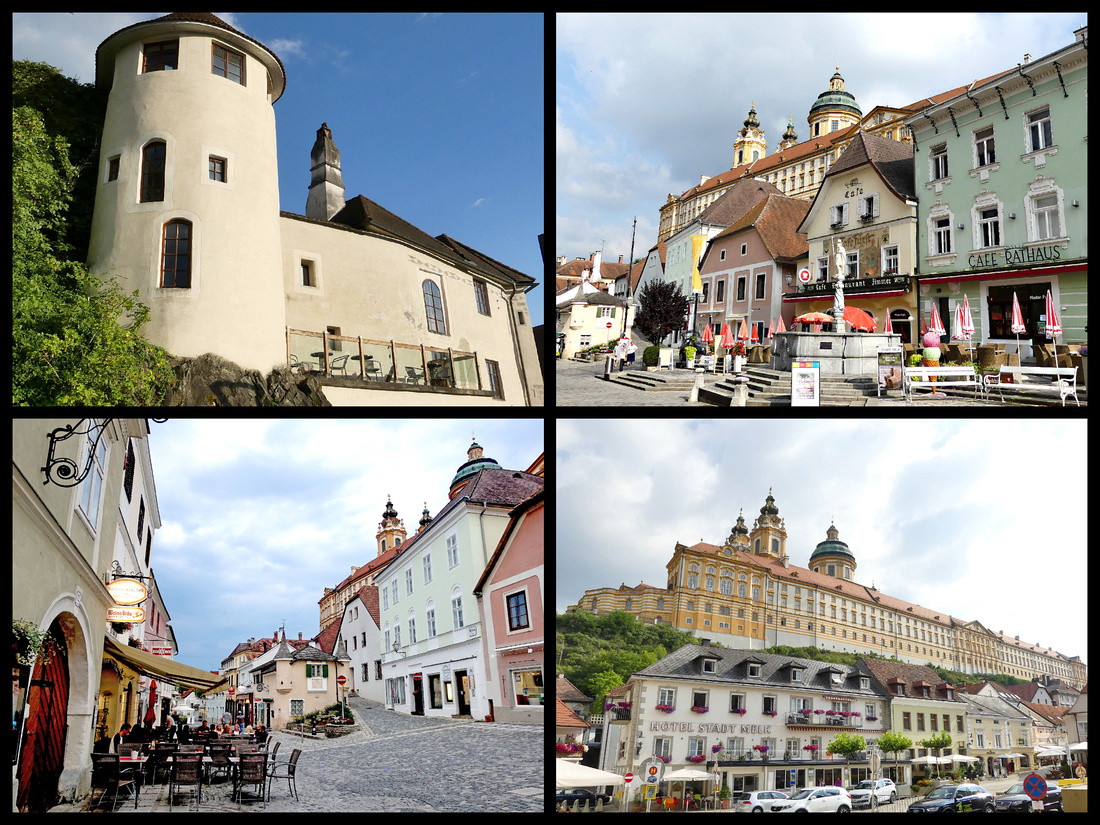

The Benedictine Melk Abbey is gigantic and very pretty in shades of light yellow and apricot sitting up on a hill overlooking the town and the river. The ‘museum’ part was pretty boring, but the actual church was amazing – considered the finest Baroque church north of the Alps. The view from the terrace was also lovey, the Baroque spiral staircase gorgeous and the library amazing. The Baroque Pavilion was built in the 18th century in the Abbey park, and it is filled with historical frescoes which show the then known continents and their inhabitants as well as their flora and fauna as imagined by the painter Johann Bergl. €11 per person.
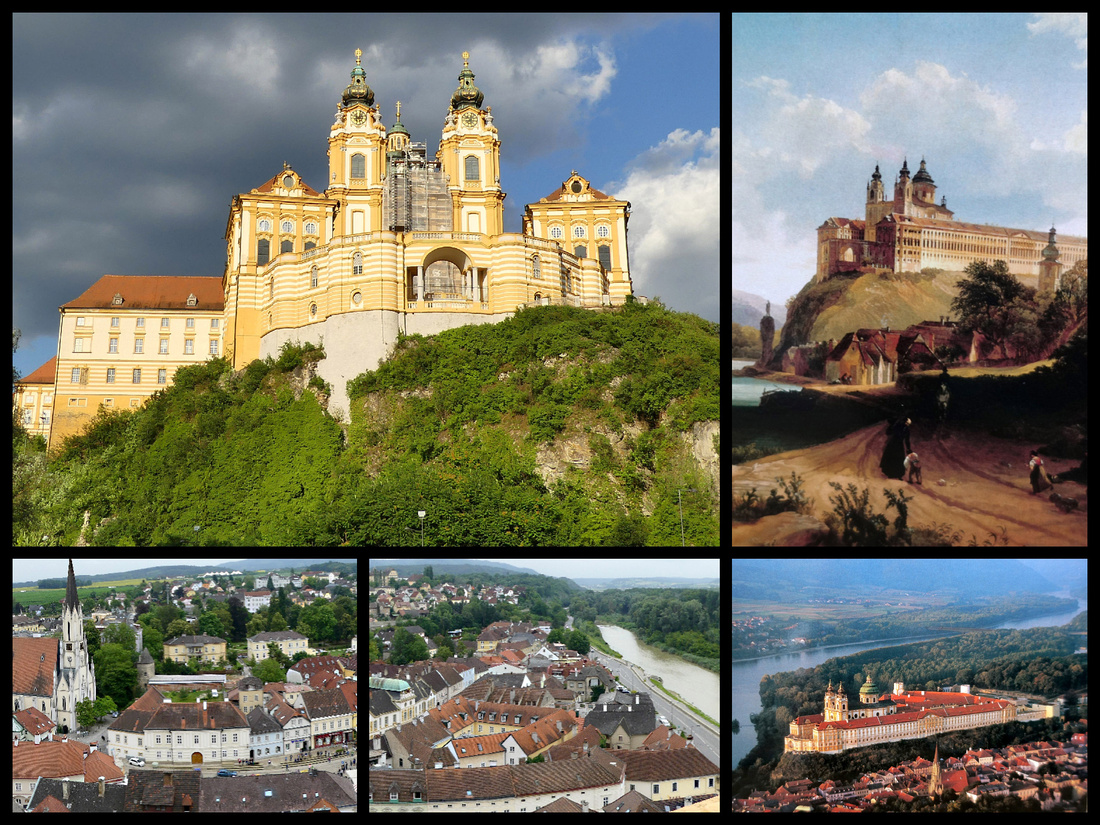
 Above - Top Left: Melk Abbey today Top Right: historical painting of abbey in medieval times
Above - Top Left: Melk Abbey today Top Right: historical painting of abbey in medieval times
Lower Left and center: view of Melk from the Abbey terrace Lower Right: a postcard view of the Abbey from above

 Above - Top photos: The Abbey Lower Left: The Baroque Pavilion in the Abbey Park Lower Right: some of the frescoes in side it
Above - Top photos: The Abbey Lower Left: The Baroque Pavilion in the Abbey Park Lower Right: some of the frescoes in side it
Danube River Cruise. Beautiful day, mostly sunny and warm but not hot. The trip between Melk and Krems (the most scenic stretch) takes 90 minutes going downstream and 3 hours back up so we opted for the quicker trip so we’d have more time to explore the towns and I’m glad we did. It’s pretty scenic but 90 minutes was plenty. There are about 3-4 cruises a day in each direction. We didn’t pre-book, got to the ticket office about an hour before the sailing and easily got tickets and then seats on the upper deck.
The Danube is almost blue when the sun is out – not ocean blue certainly. But the scenery is of course lovely, hills, many covered with vineyards, cute little villages and a few castle ruins. Nowhere near the castles of the Rhine though. Much less ‘traffic’ on the river too. Mostly the river cruise boats (Like Viking River Long Boats but many different companies).


After debarking in Krems (population 24,000) we first walked in the opposite direction from the main part of town to Stein, which used to be a separate town but now blends in with the rest of Krems and I think was the prettiest part of the city. The main gate into Krems itself, Steiner Tor, is a ‘wow’ and the Alstadt past it, was nice enough, pretty lively, full of shops and people. We stopped for ice cream just inside the gate and got largest bowl of ice cream for €2.50 I’ve ever seen.
Above - The area of Krems known as "Stein"
Krems is the 5th largest city in Austria and is located 43 miles west of Vienna. It sits at the confluence of the Krems and Danube Rivers and was first mentioned back in 995 as an established town. Krems has an impressive claim to fame – it is the location of the oldest grave in Austria, a child’s grave that is over 27,000 years old. It was also one of the first places in Austria to produce coins, back in 1130. Steiner Tor is a 15th century (1480) preserved gate and is the symbol of the city. Until the end of the 19th century, Krems was completely surrounded by a medieval wall and four city gates until they were removed as the city expanded. In 2005, Krems celebrated the 1,000-year anniversary of the city and in celebration, they restored Steiner Tor to its former glory.
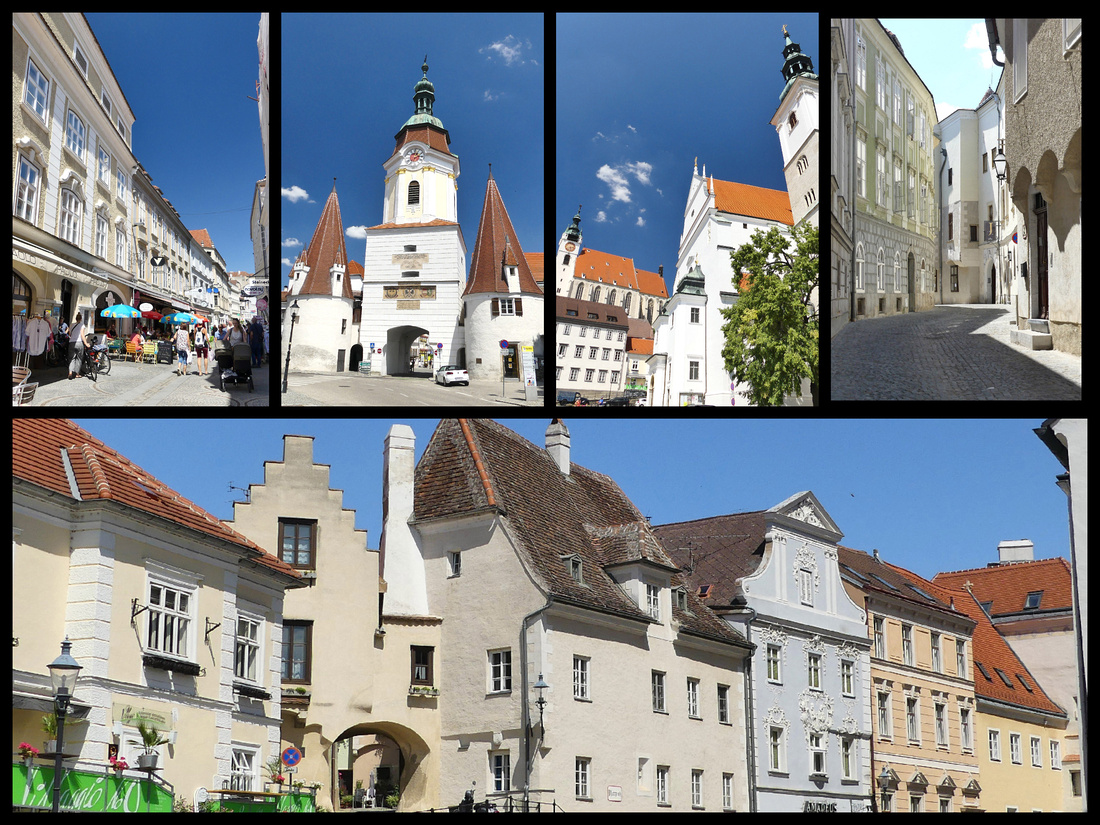

The bus station is right next to the Train Station. There are signs for the various buses, and schedules but no ticket office or kiosk. But the bus came right on time and we were able to buy the tickets from the driver. We got tickets only as far as Durnstein (€2.30 each).
Durnstein (population 870) is adorable – set on the river, amidst vineyards on both sides and behind the town, and high up on the hill an old castle ruin where Richard-the-Lion-Hearted was kidnapped and held for ransom when returning from or going to some Crusade. Old town walls on both sides of the village. Durnstein Abbey is the most striking church in the area, a beautiful large blue baroque church right on the river. The town is really only one main street, but lined with beautiful old houses. It was packed with people when we got there (3:30) but most of them disappeared within an hour (I think boats heading in both directions picked up a lot of them). There were lots of bikers and of course independent travelers who came in cars (parking lots on the outskirts) or like us on the public bus, but I didn’t see any tour bus groups.




Next: Back to Bavaria - Passau, Nurnberg, Bamberg, Regensberg, Rothenburg, Heidelberg
